Disclaimer: This post contains affiliate links to handpicked partners, including tours, gear and booking sites. If you click through or buy something via one of them, I may receive a small commission. This is at no extra cost to you and allows this site to keep running.
This guide to the best places to visit in Malta highlights all the main attractions that span the entire island, showing there’s a big adventure to be sought on this small island.
When you visit Malta, you’ll find a tiny landmass big on nature, centuries-old culture, and fascinating history. Wedged between southern Italy and the coast of North Africa, Malta is easily overlooked in favour of its popular neighbours, except you’ll find more to see, do and experience here than you first thought.
You can flit between beaches, adventure nature havens, historical landmarks, and cultural relics in a single day via a comprehensive public transport system on land and water, but where do you begin?
This Malta guide navigates you around the island, taking in the top attractions, viewpoints, walled cities, and culinary highlights across this 316-square-metre landmass, split into north and south for easy planning.
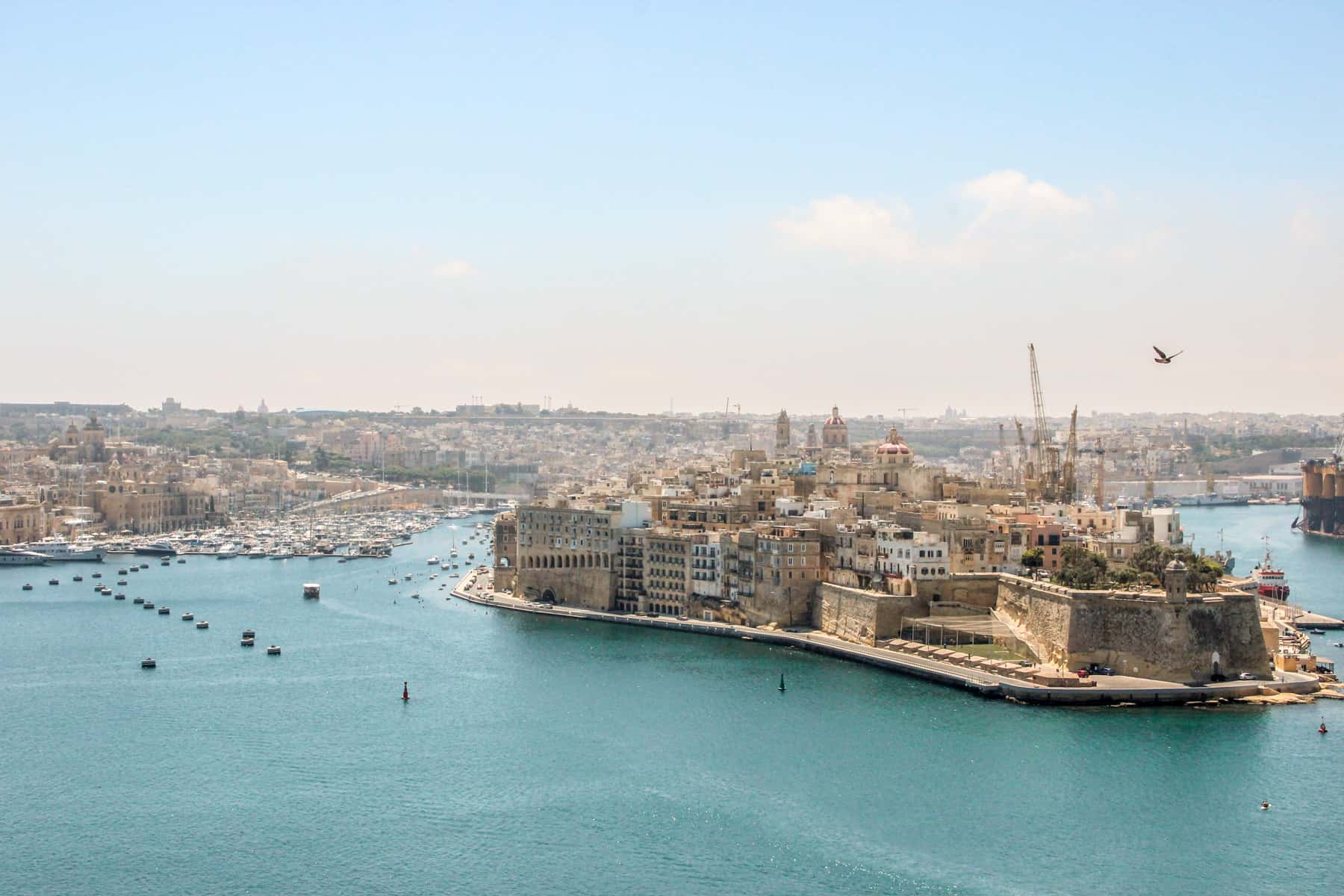
The Best Places to Visit in Malta – 20 Island Hotspots to See
Contents
- A Brief History of Malta
- Visiting Malta – Itinerary and Planning
- Best Places to Visit in Malta – In the South of the Island
- The Fortified City of Valletta
- The Three Cities of Malta
- The Three Villages of Malta
- Medieval Mdina – “The Silent City”
- Arab Rabat for the Best Pastizzi in Malta
- The Brewhouse – The Farson’s Brewery Experience
- Dingli Cliffs Hiking Hotspot
- Girgenti Olive Groves and Vineyards
- Ghar Lapsi for Maltese Nature
- Zebbug Local Maltese Village
- Marsaxlokk Fishing Village
- Sliema, But Only for the View
- Mosta Dome – The Beloved Landmark
- What to See in Malta – On the North of the Island
- Is Malta Worth Visiting?
A Brief History of Malta
The Arabs once occupied Malta for over 200 years before it became a part of the Roman Empire. It was later ceded to the Knights of St John for protection, who transformed it over 268 years with baroque architecture, palaces, churches, fortifications and aqueducts.
The Knights protected the island from the Ottoman Turks before it fell briefly to French rule with the arrival of Napoleon in 1798. Malta then called upon the British for assistance, becoming a part of the British Empire. However, its strategic location and alliance meant Malta suffered heavily during World War II – making it one of Europe’s most heavily bombed areas.
Malta gained independence in 1964 and later joined the EU in 2004.
In short, Malta once adopted a Semitic language (which is still prevalent today), has elements of Italian culture and cuisine due to its proximity to Sicily, saw the birth of Christianity with the arrival of the Romans (the island has over 360 churches), changes to legal and education systems with the arrival of the French and vast changes in the way it was administered because of the British, alongside adopting English as the second official language.
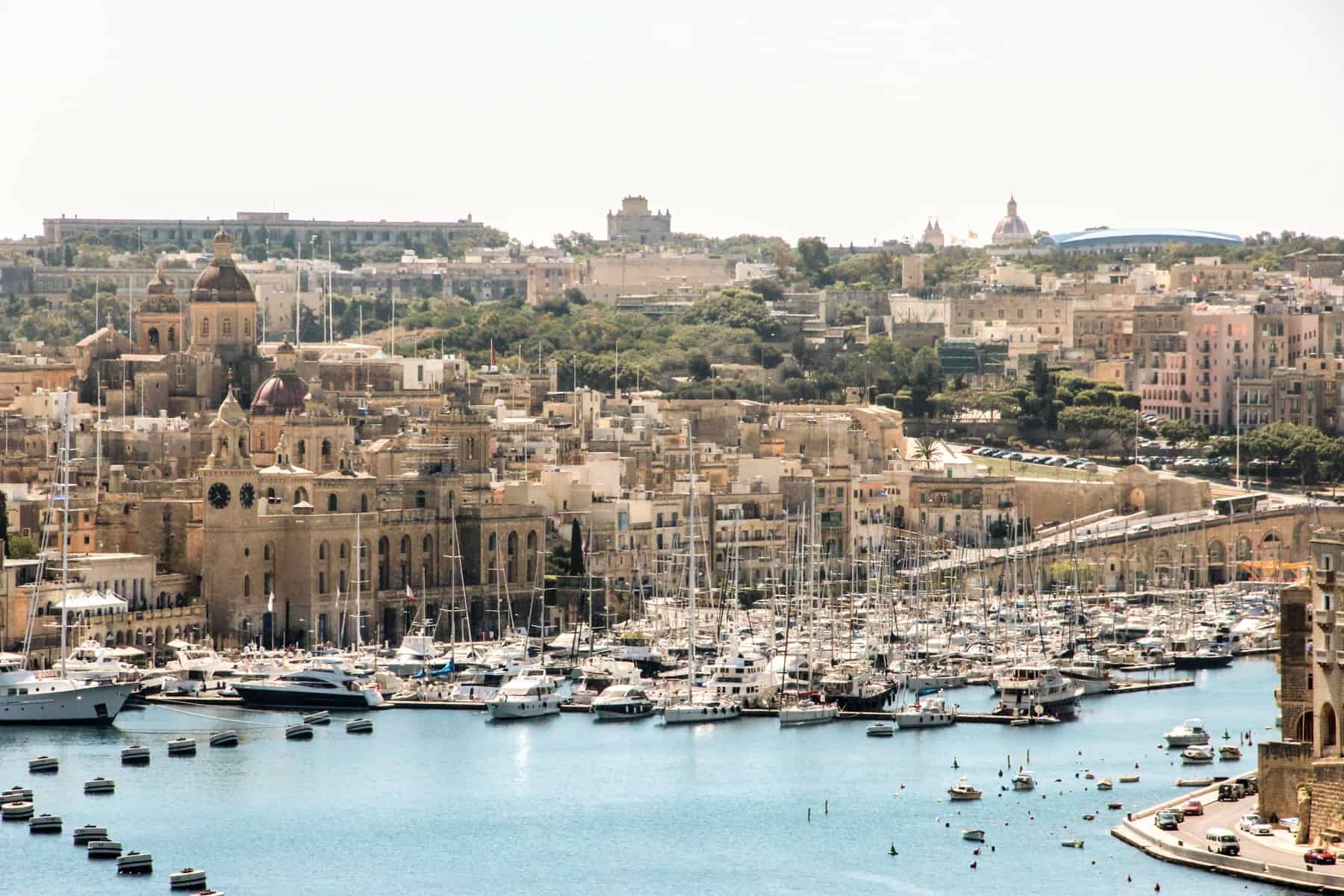
Malta’s history and occupation have resulted in a mix of cultures that coexist today.
Visiting Malta – Itinerary and Planning
Malta today is an island for those looking for a cultural trip. One that draws you into days of exploration and in a very accessible country to travel around and take in the major highlights, as you can see from the answers to some common questions about Malta below.
At the heart of tourism in Malta is the sheer variety of things to see, places to go, historical points of interest, attractions and viewpoints. The lesser-known corners of Malta can only be reached via a willingness for explorative travel.
Where is Malta located?
The country of Malta is an archipelago of three islands in Europe, located in the Mediterranean Sea south of Sicily, Italy, and north of the African countries of Libya and Tunisia. The three islands of Malta, Gozo and Comino are all open for exploration. Locals live on Malta (the biggest island) and Gozo, with Comino, with just two residents, being a nature reserve known for its bird population.
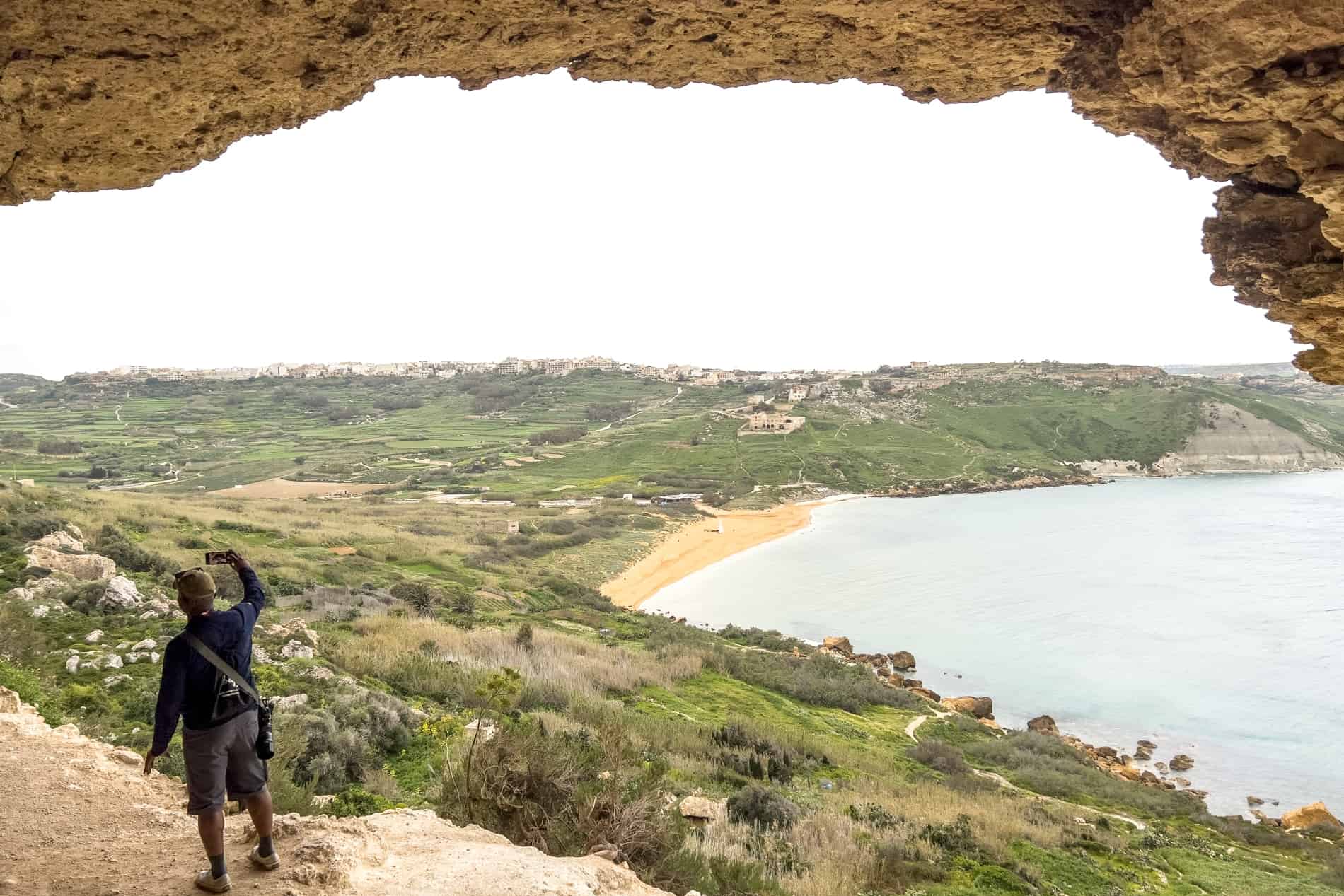
Tal Mixta Cave on the less developed and pristine Gozo Island in Malta.
How big is the island of Malta?
Luckily Malta’s small size of around 316 square kilometres makes it all the more accessible to explore. Such a size is perfect for long coastal walks or a leisurely road trip.
How many days do I need for Malta sightseeing?
With neighbouring Gozo and Comino islands also topping the list of places in Malta to visit, you might need more than a long weekend for your trip to Malta. It deserves a lot more of your time, although a four-day trip will enable you to cover a lot of ground.
How long does it take to get from one side of Malta to the other?
In around one hour, you can cross the island of Malta in one direction by bus or car, covering a distance of around 27km long and 14.5km wide. As there is a lack of vast open spaces, the special thing is the changes in landscapes in that short time, where you will likely move from quiet communities and little bays to beaches and bustling small cities.
Getting Around Malta
Best Transportation in the Maltese Islands?
The Malta bus network is a prime option for most visitors, and there’s a great hop-on-hop-off tourist bus system where you can reach all the island’s main points.
However, with a car, the more avid island explorers can uncover more of magnificent Malta.
Ferries and Water Taxis in Malta
There’s a ferry system in Malta that connect Silema with Valletta and Valletta with the Three Cities of Malta. It costs €1.50 for a one-way journey and €2.80 for a return.
Motorised boat, Water Taxi services are also available, costing €2 for a single crossing to up to €10 for a Grand Harbour Tour or similar.
Ferries to Gozo island leave from the northernmost point of Malta island, in the area of Cirkewwa.
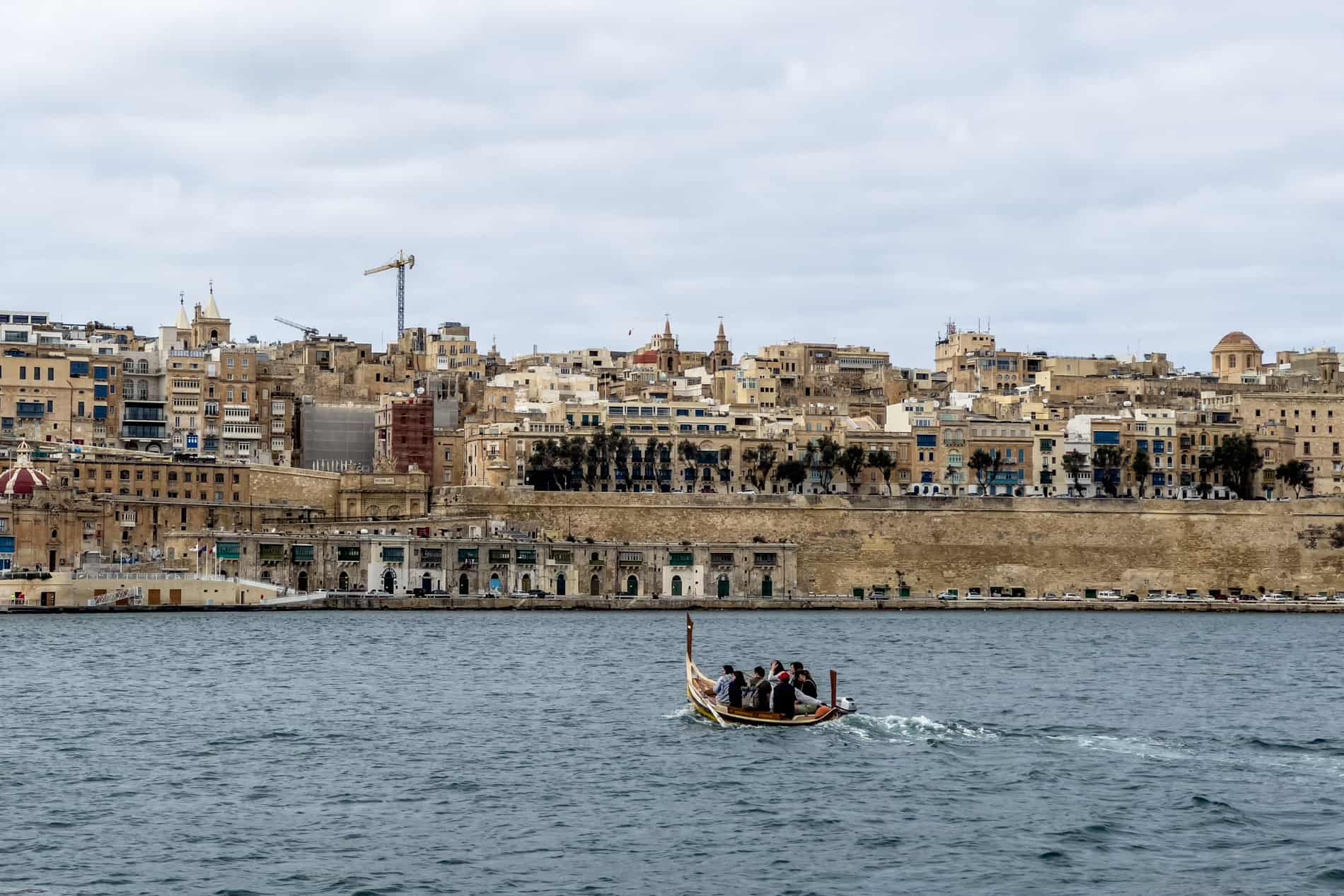
Journey to Valletta. Taking a Water Taxi in Malta.
Malta Sightseeing Bus
Not everyone enjoys the hop-on hop-off bus services, but for some, it’s a more convenient means of getting around a destination at your own pace. Malta’s sightseeing buses are split into two routes – South Malta Route (which includes Valletta, The Three Cities, Marsaxlokk Fishing Village, Hagar Qim & Mnajdra Temples and more) and the North Malta Route (including Mdina and Rabat, Mosta Church and Golden Bay, among other sites). You’ll need to start early to cover both as the buses don’t run into the evening.
There is a similar sightseeing bus in Gozo, with 15 sightseeing stops.
Malta Day Tours
Short on time and want to see the highlights with a local? Take a full-day tour of Malta and be guided around the must-see spots of the island, from villages and fortified cities to catacombs and clifftops. Tours run in English, French, German, Italian, and Spanish.
Driving in Malta
To embark on a Malta road trip, you must be a great driver since Maltese roads can be tricky to navigate. Luckily for me, my chauffeur was a friend from the island, so I had my own local tour guide to show me around, get my bearings and understand the workings of the road (and Maltese drivers) better.
If you don’t want to drive, Bolt is the go-to ride order app on the island – I used it frequently on my recent visit. Drivers arrived quickly, and journeys were not overpriced.
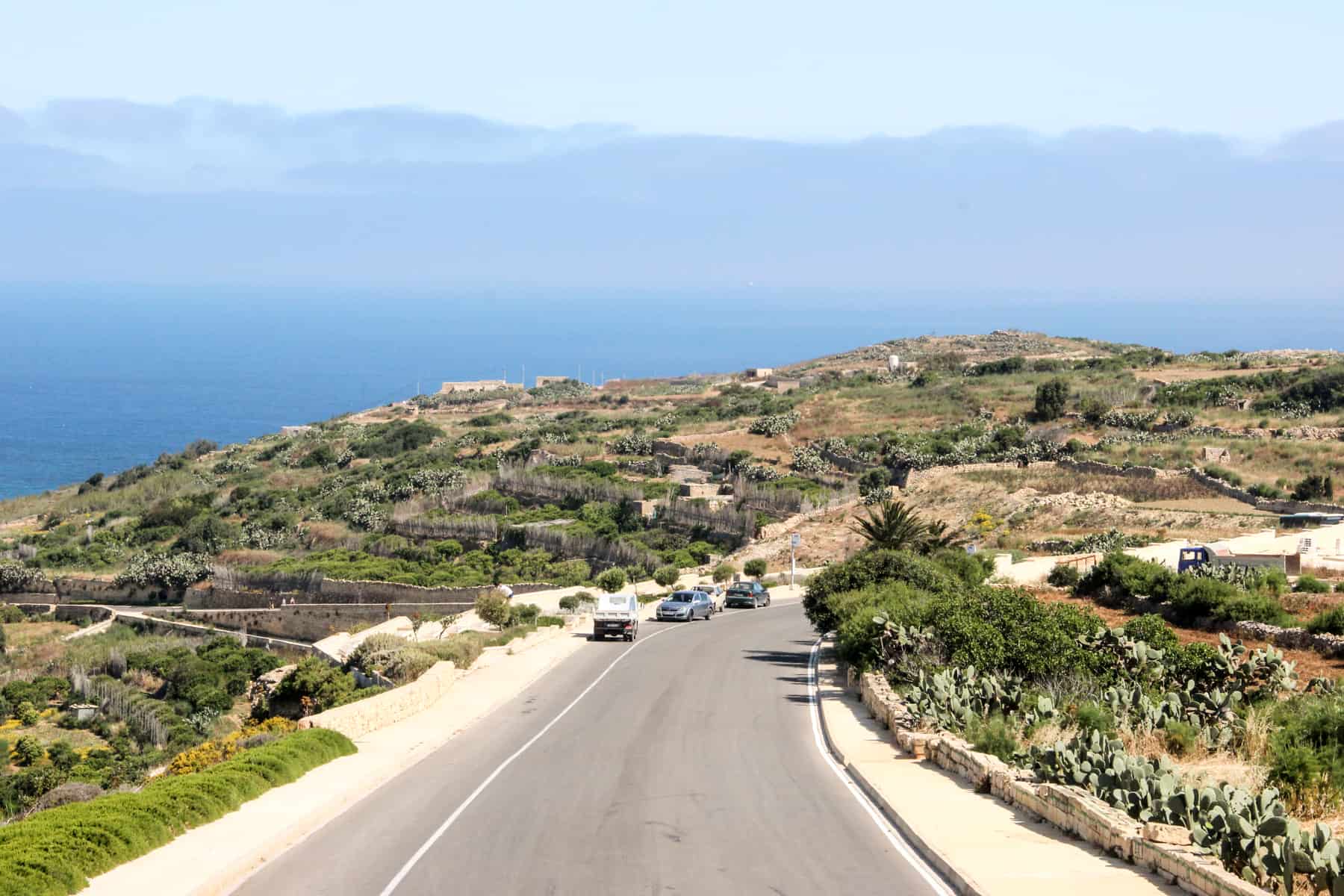
Driving in Malta.
Is Malta Safe?
It is considered safe to travel in Malta, having had no known conflict activities or history of terrorist attacks. I felt safe and at ease in the secluded and hidden parts of Malta and the more bustling areas like St. Julian’s, where the worst thing you might see is a typical drunken outburst.
Where to Stay in Malta
Malta City Living
Valletta will likely be your main base or the first area you explore on Malta Island. One of the most wonderful things about Valletta is that you can experience the one dominant noble excellence of living by staying in a ‘Palazzo’ such as the Palazzo Prince d’Orange – a beautiful 17th-century apartment hotel where I stayed that’s right near to the harbour.
READ MORE: About Palazzo in Malta for further information.
Malta Beach Side
If you want to spend some days beachside, the Mellieha Bay and Sliema resort areas are considered top choices to find a base.
In the village of Mellieha, the Pergola Hotel & Spa is good value for money, just 15 minutes walk to the beach and with views to the islands of Gozo and Comino, as well as the surrounding bay.
In Sliema, check out the D Townhouse Boutique suites – a modern furnished less than 10 minutes from the beach and ferry terminal and a popular choice that quickly sells out.
Best Places to Visit in Malta – In the South of the Island
My road trip expedition allowed me to pull together this Malta attractions guide with 20 of the best places to visit around the island, including some of Malta’s hidden places.
The Fortified City of Valletta
Between Europe and Africa, Malta’s strategic position made it a target for invaders over the centuries, and it’s why you’ll find walled citadels on the island – Valletta being the grandest of all.
Opulent Valletta is a UNESCO World Heritage Site, and missing this magnificent walled city built by the Knights of St John is impossible. A true cultural and historical hub, Malta’s capital city of Valletta is exquisite in design, and it’s no wonder it was the European Capital of Culture 2018 and remains top of all the Malta sights.
Its navigable streets are lined with markets and complemented by manicured gardens. All around you are beautiful balconies and grand noble houses. The old city retains its fort, harbour, and historical structures like churches, theatres and the Grandmaster’s Palace.
A bustling café culture, al fresco dining options and reinvented boutique bars fill the gaps in between. This guide to Valletta goes into more detail about what to see and do there.
Valletta Tours
Take a three-hour walking tour of Valletta’s highlights with a local guide, or solve riddles in your own time while learning the history of the sites you uncover on this self-guided scavenger hunt city tour of Valletta.
This three-hour walking tour includes a guided visit to St. John’s Cathedral – one of the greatest landmarks of the city. Adventure buffs can tour Valletta’s streets by segway, stopping at some of the city’s magnificent viewpoints.
Get to know Valletta’s history while sampling Maltese cuisine on this street food and culture walking tour.
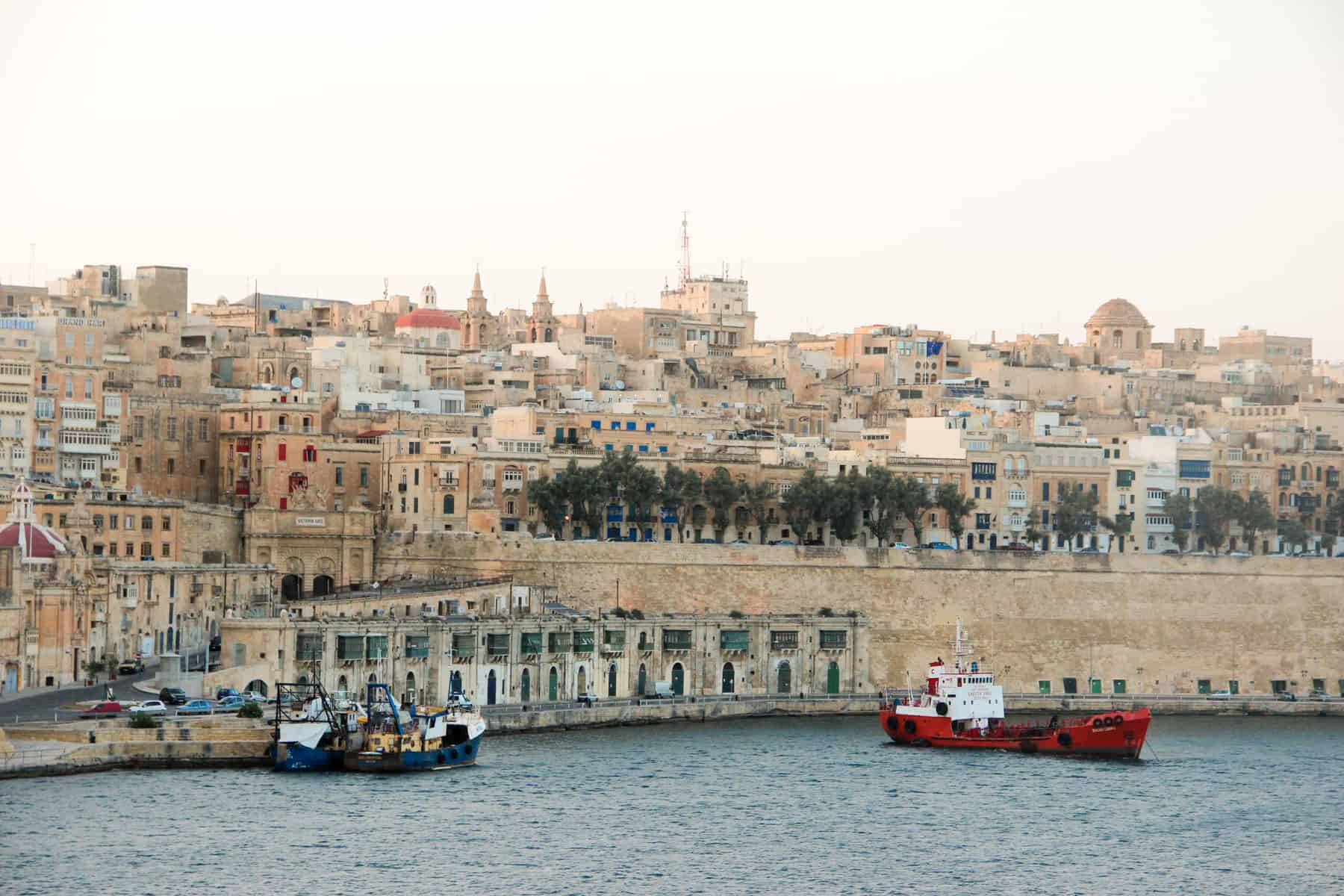
The old town of Valetta on the island of Malta.
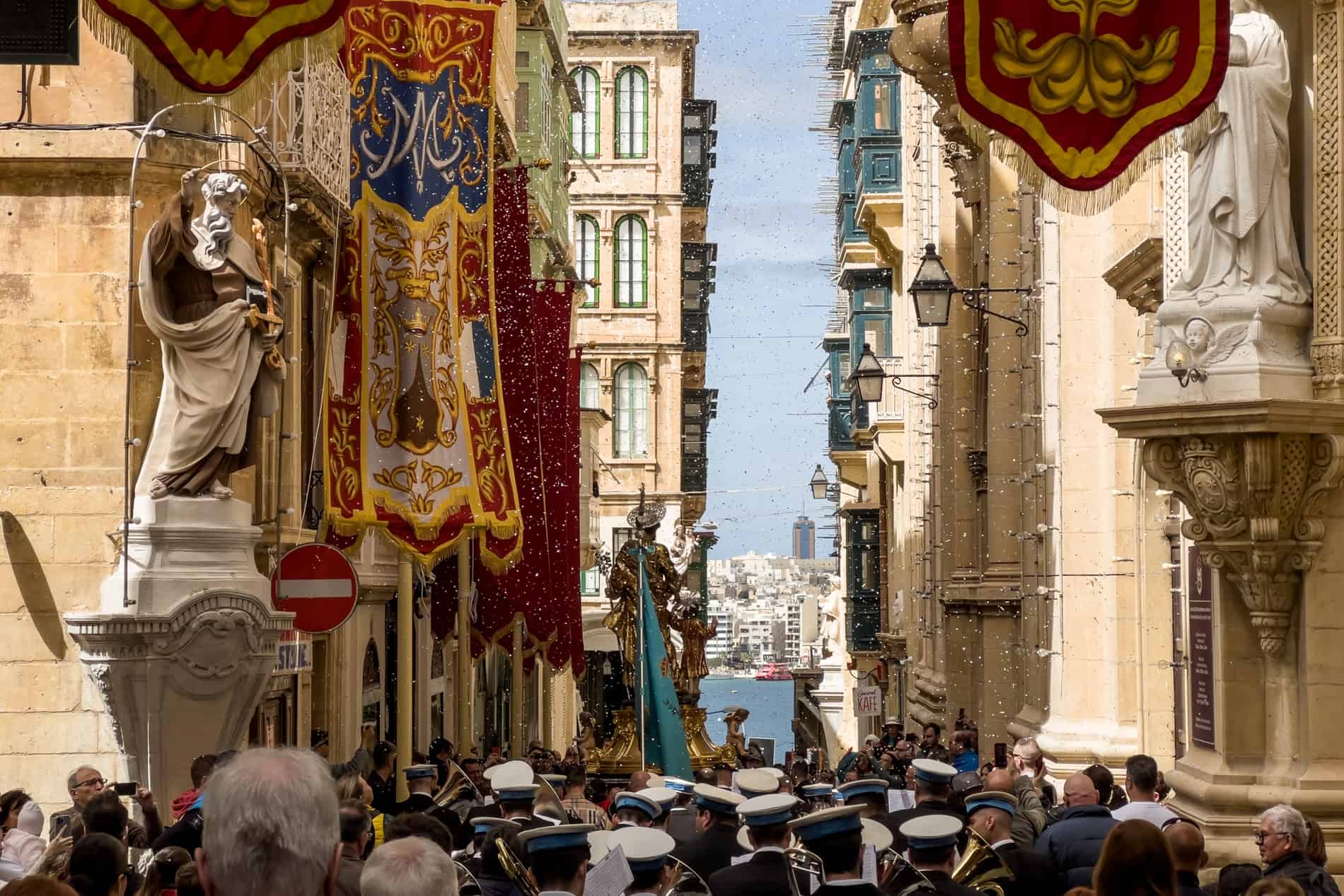
The streets of Valletta during the Feast of St Joseph on March 19th.
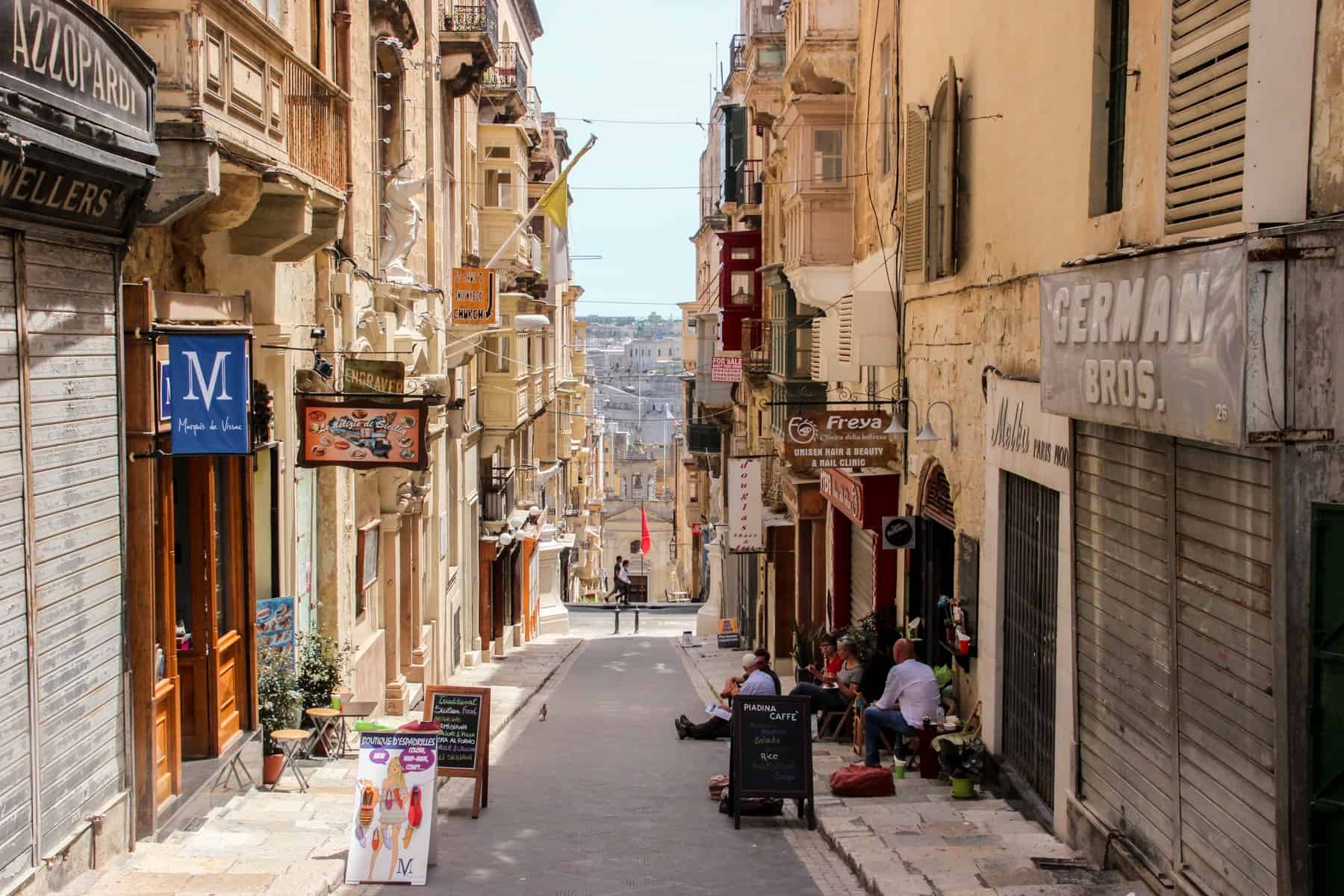
Life in old Valletta, Malta.
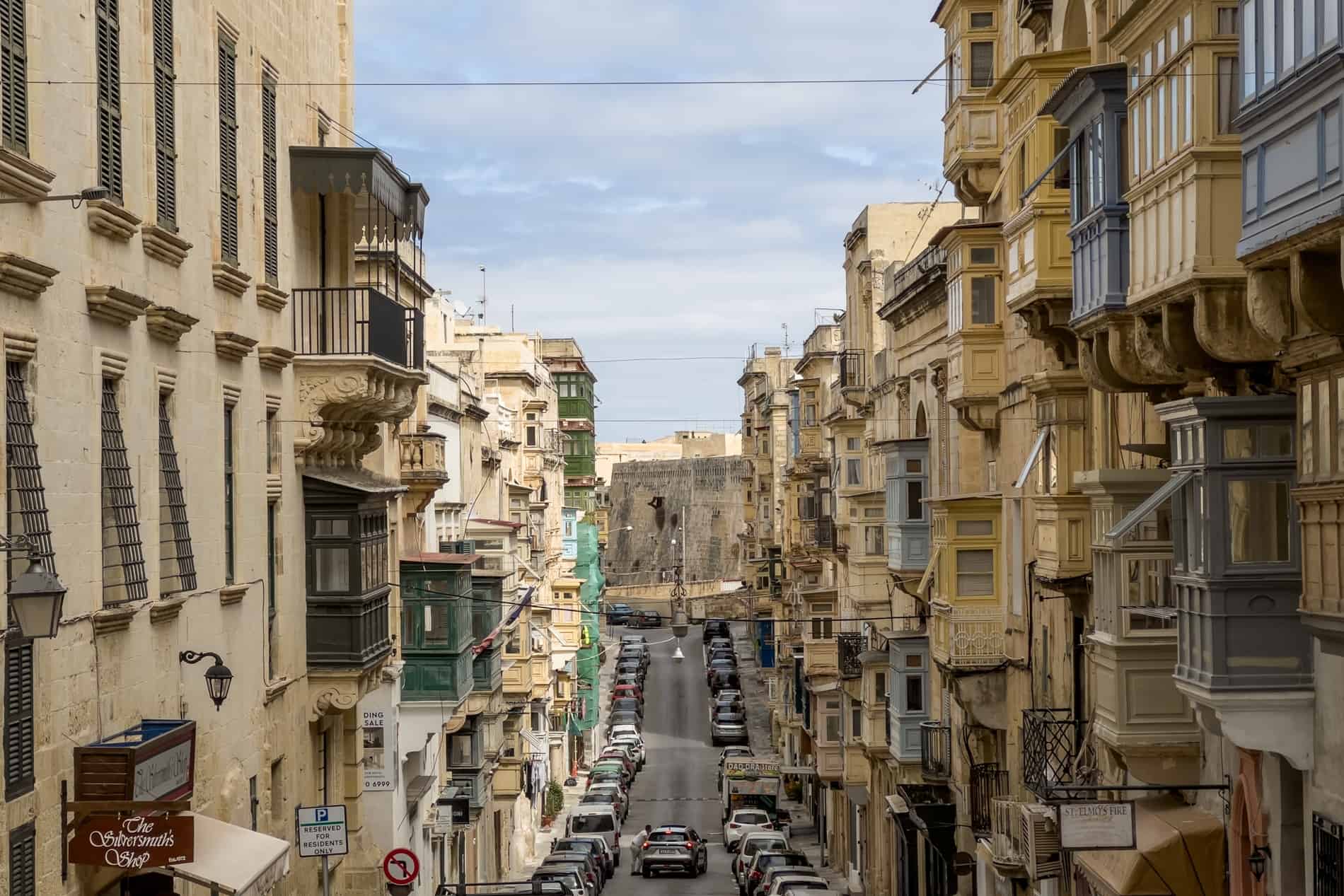
The Golden, balconied streets of Valletta.
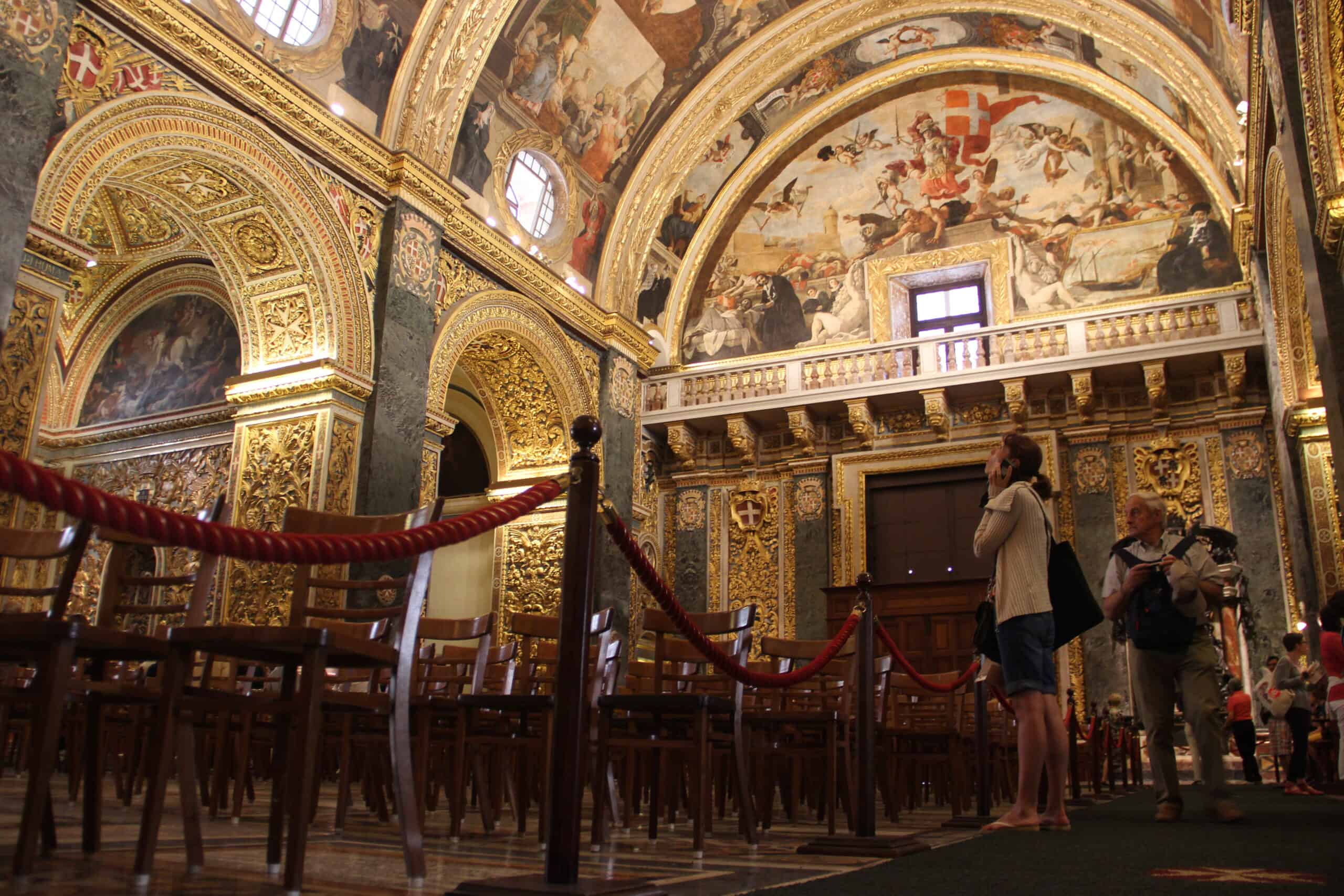
Inside the gilded, muralled St John’s Cathedral in Valletta.
The Three Cities of Malta
From Valletta, take a short and scenic ferry journey to the Three Cities of Malta – Vittoriosa, Senglea, and Cospicua. Malta’s fortified trio of cities south of the Grand Harbour were used as a base for the Knights of St. John (between 1530 and 1798) before Valletta was built as the main stronghold.
Limited on time? The ‘Happy Train’ trundles around the highlights with historical commentary. It starts and ends at the Vittoriosa waterfront and costs €6.
Vittoriosa
Vittoriosa, also known as Birgu, is the oldest of the three cities and where the Knights of St. John’s held their first commanding position. It holds historical significance as a place of refuge (alongside Mdina) during the Ottoman invasion of the Great Siege of Malta in 1565. You’ll notice it from afar by the grand Fort Sant Angelo. Wander the winding streets that cradle opulent architecture like the Maritime Museum and Inquisitor’s Palace, encased by the remains of defensive walls.
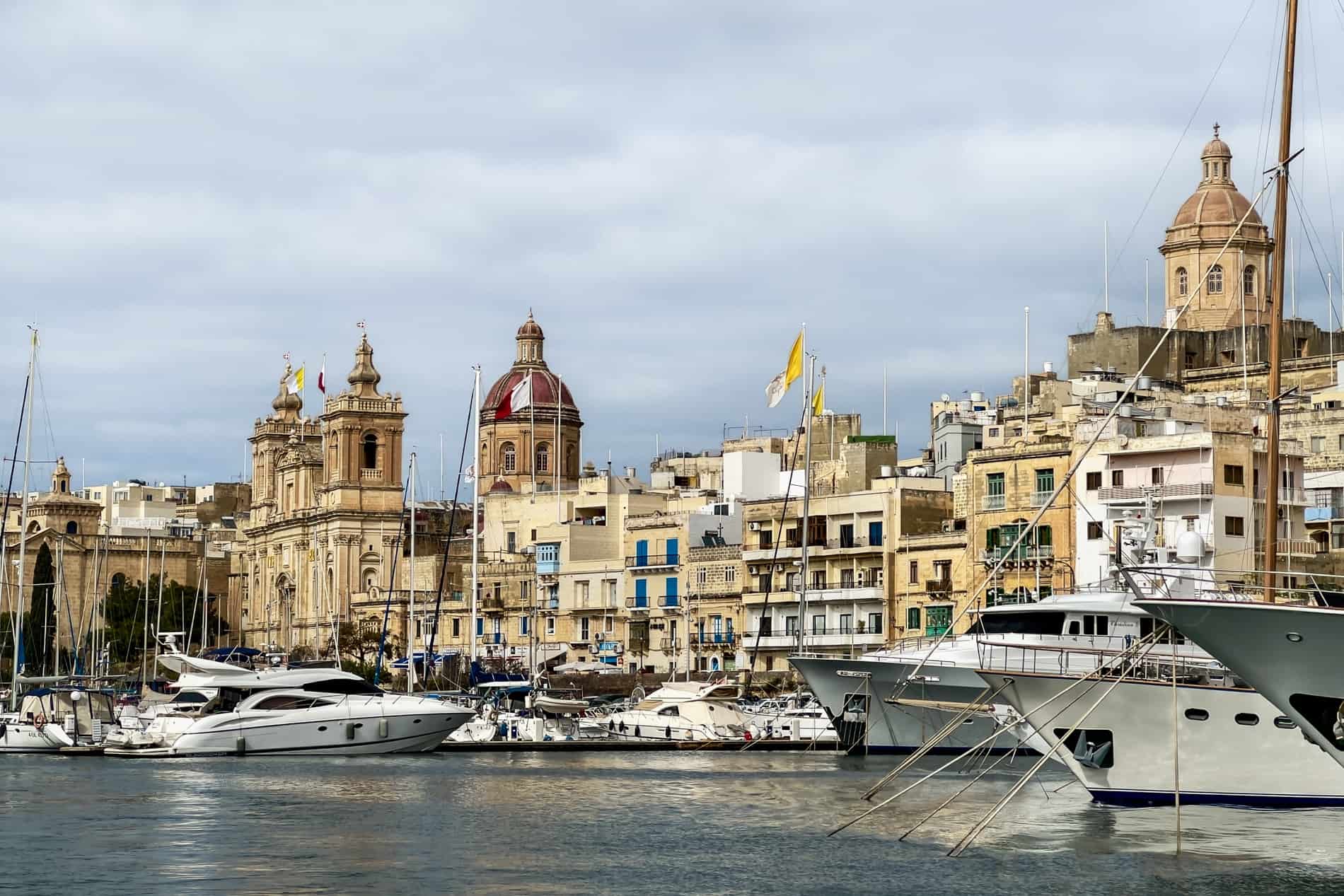
The opulent waterside of Vittoriosa.
Senglea
Senglea, also known as Isla, is located on the peninsula opposite Vittoriosa and was also built by the Knights, who named it after their Grand Master, Claude de la Sengle. See the fortifications of Senglea near the bottom of the peninsula and head to the Gardjola at the tip of the inlet to get to a gorgeous viewpoint of Valletta and the port.
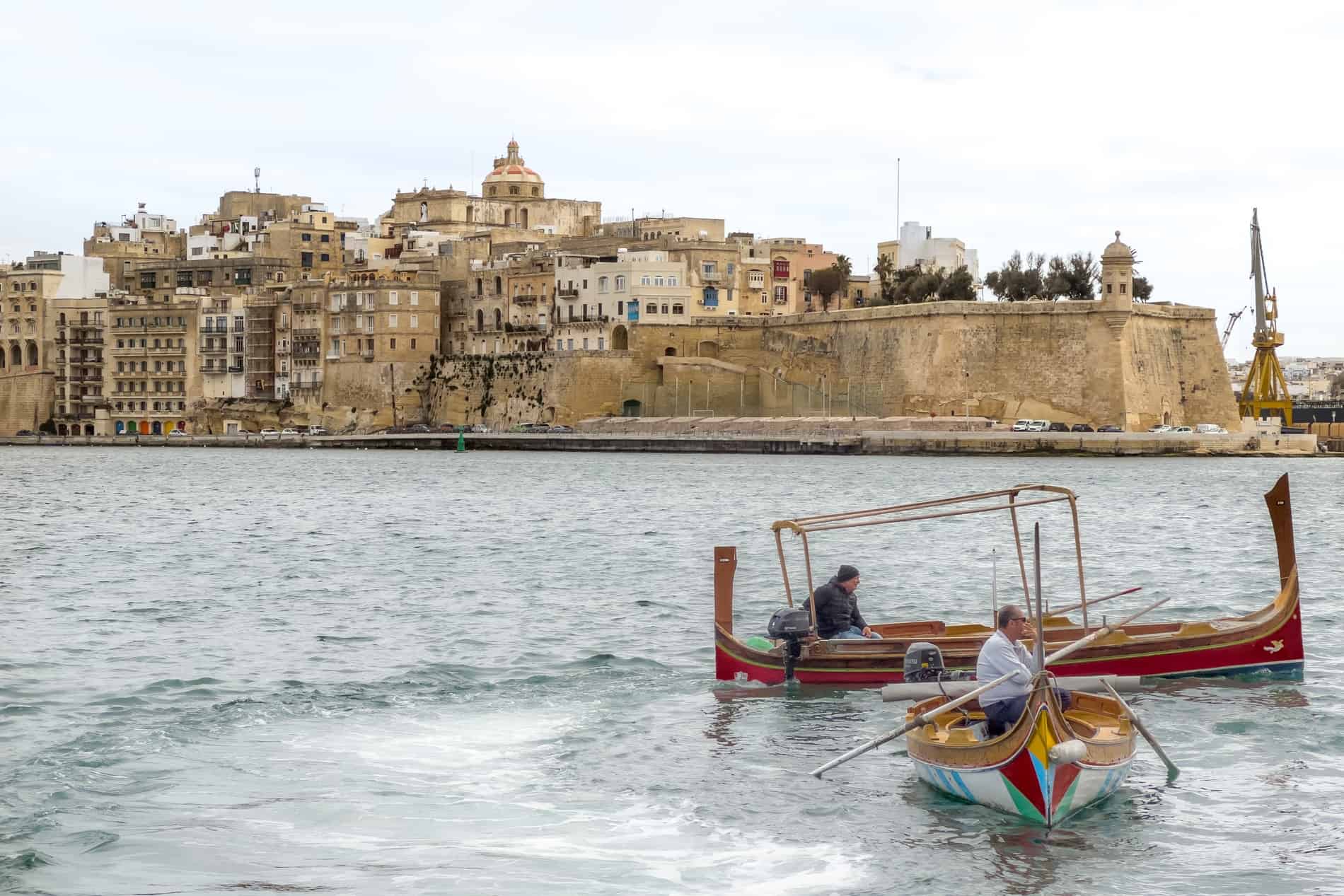
View of Senglea across the Grand Harbour from Valletta.
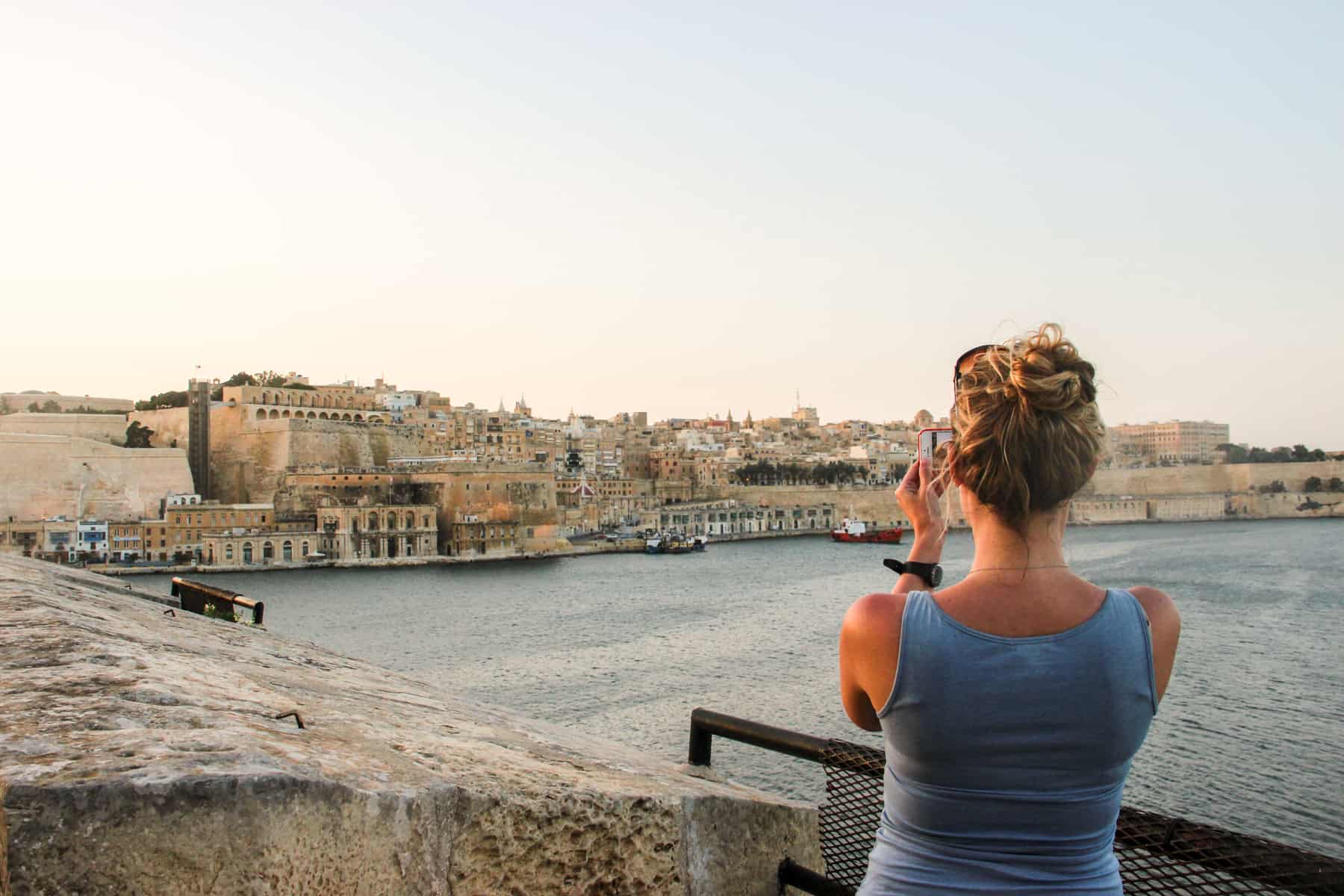
Find the beautiful viewpoint of Valetta from Gardjola, Senglea.
Cospicua
Cospicua, also known as Bormla, is the largest of the Three Cities of Malta but is more of a residential area pocketed with important historic buildings, including St. Helen’s Gate, the Church of the Immaculate Conception and the fortifications known as The Cottonera Lines.
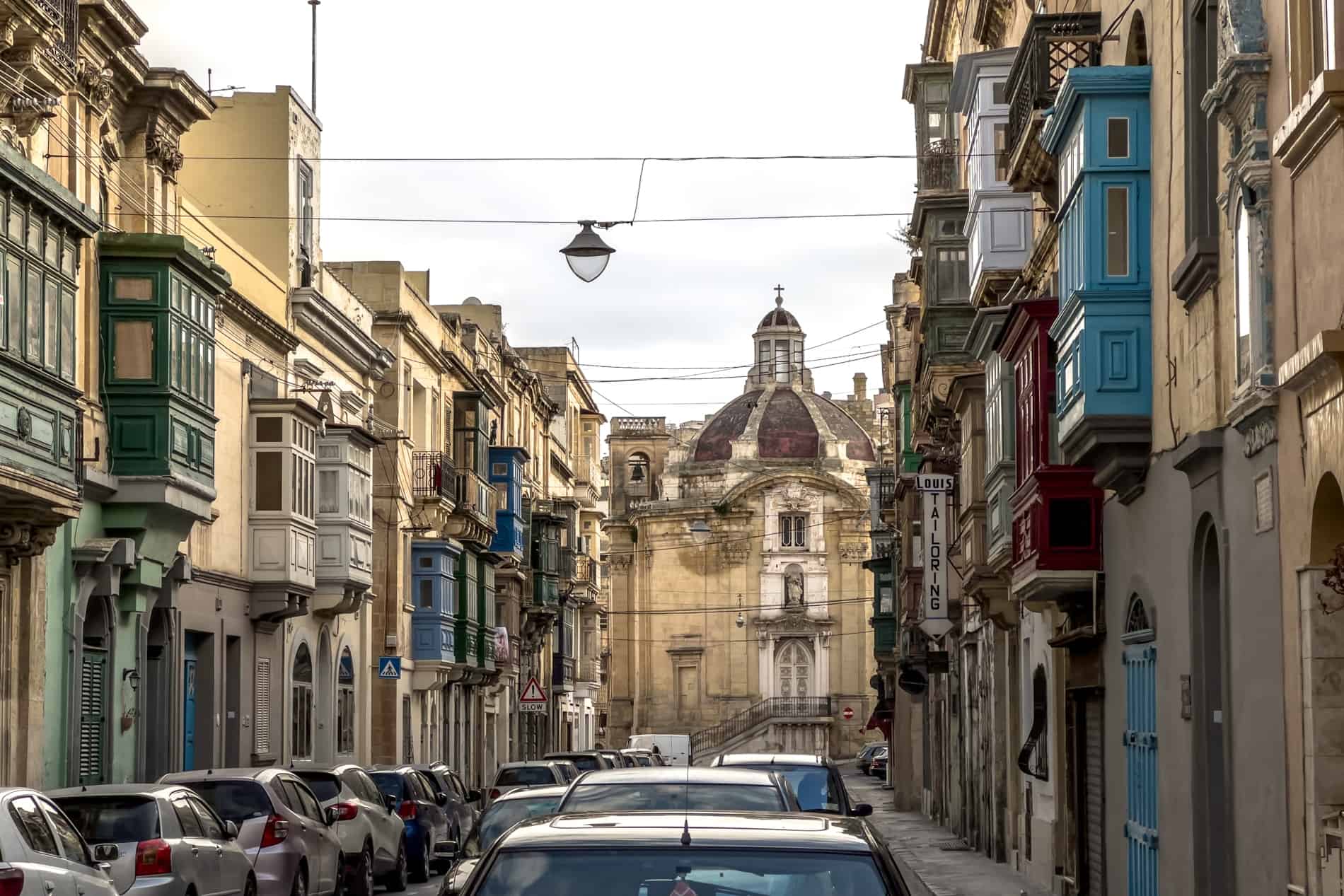
Cospicua – one of the Three Cities of Malta.
The Three Villages of Malta
Balzan, Attard, and Lija form “The Three Villages” of Malta, which sit within the centre of the island. While not overly abundant on sites, this is a quiet and picturesque area to drive through, lined with classical structures and the San Anton Palace and Gardens, which accommodates the Presidential Palace to this day.
Medieval Mdina – “The Silent City”
The oldest and first capital of Malta, Mdina’s tiny space is chock full of architectural splendour, which begins at the grandiose Mdina Gate. Its silent city namesake comes from the period of the arrival of the Knights of St John when its inhabitants deserted it for the newly instated capital of Vittoriosa.
The nickname doesn’t refer to it being quiet today. It’s crowded – not just for those coming to admire its beauty but also because it was a filming location for Game of Thrones.
You can take a horse-drawn carriage through Mdina, but it’s wholly navigable by walking. Venture into the warren of side streets filled with courtyard restaurants, shops, and museums surrounding squares filled with exquisitely detailed Palazzos and landmarks like the St. Paul’s Cathedral from 1702, or take a walking tour of Mdina and Rabat with a local guide for deeper historical context.
Mdina is also home to the best chocolate cake on the island, which can be found at the Fontanella Tea Gardens – be sure to get a good seat to secure a sweeping view of the island.
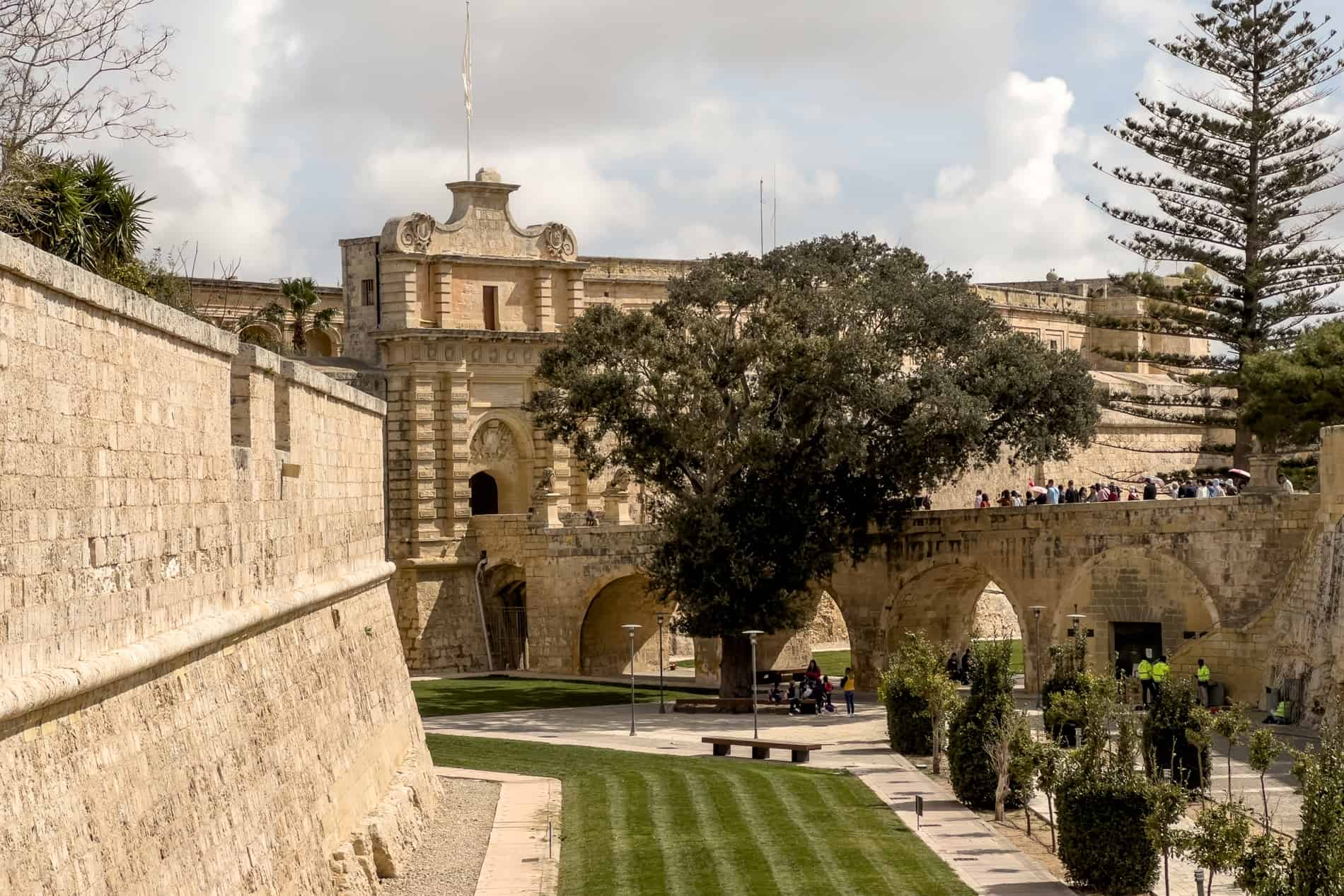
The fortified city of Mdina, Malta.
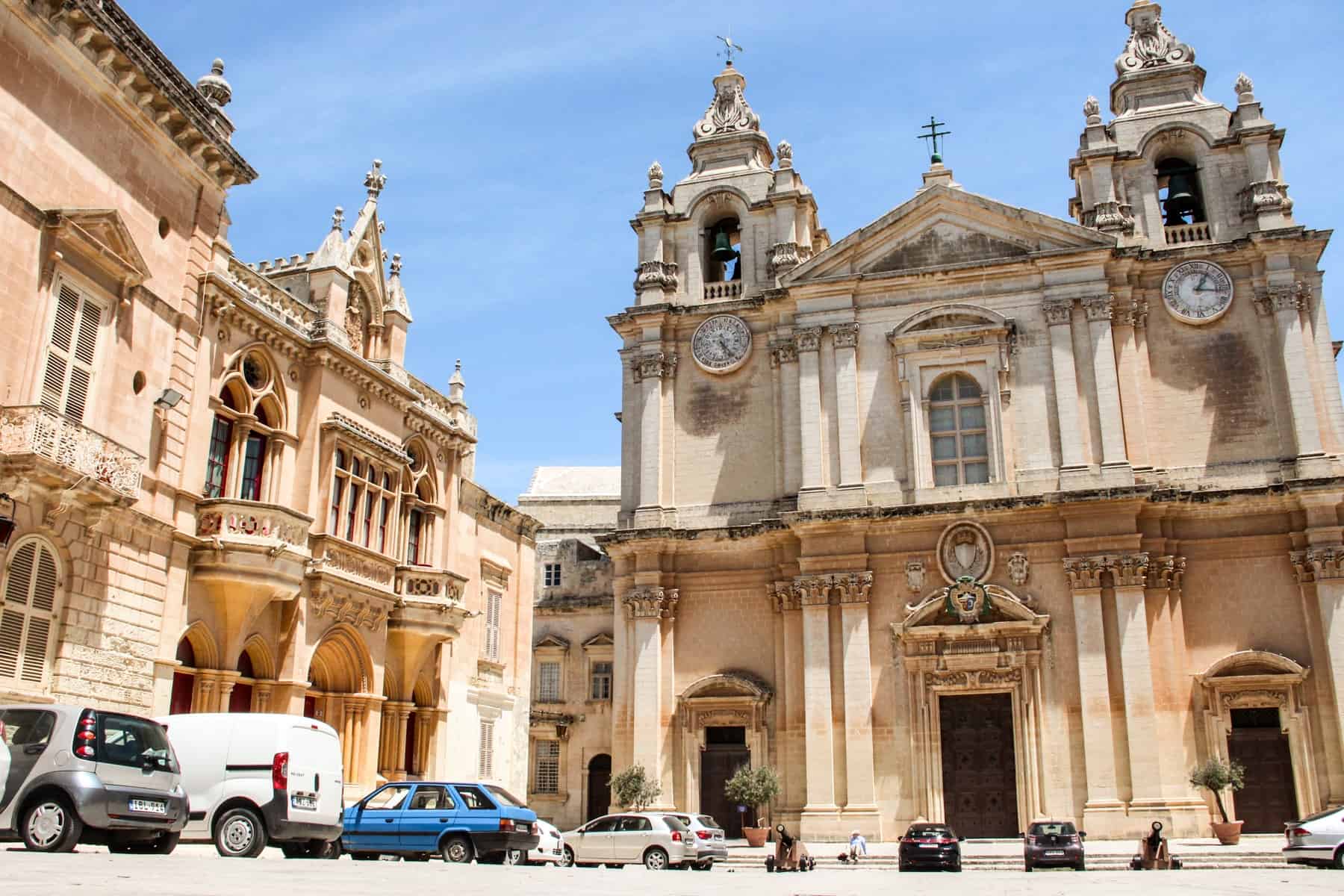
The magnificent architecture in medieval Mdina.
Arab Rabat for the Best Pastizzi in Malta
Another architecturally rich town that was once a suburb of old Mdina is Rabat. It’s also where you can find the Catacombs of St Paul – a slightly spooky but fascinating underground explorer’s haven.
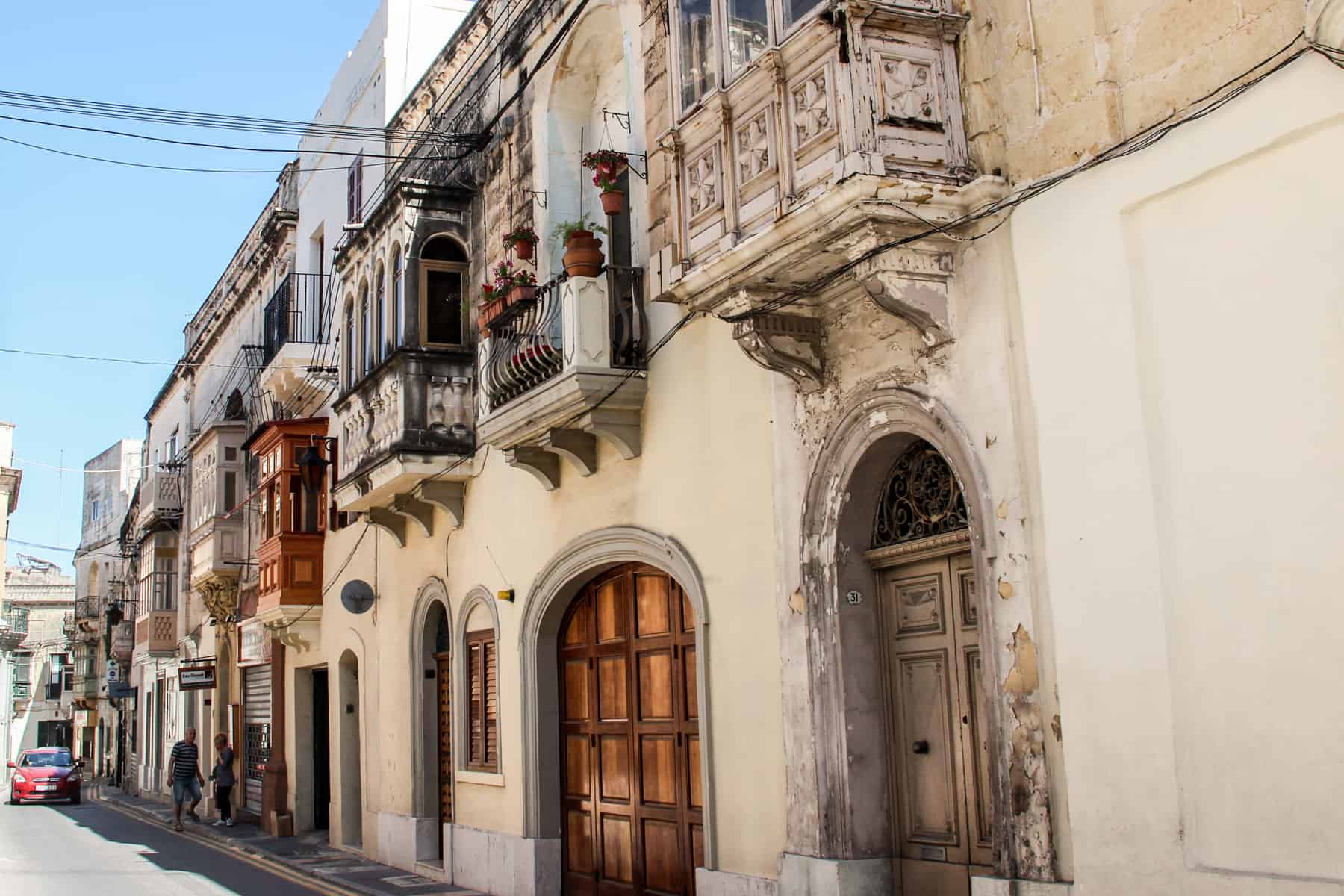
Wander the architecturally rich Rabat.
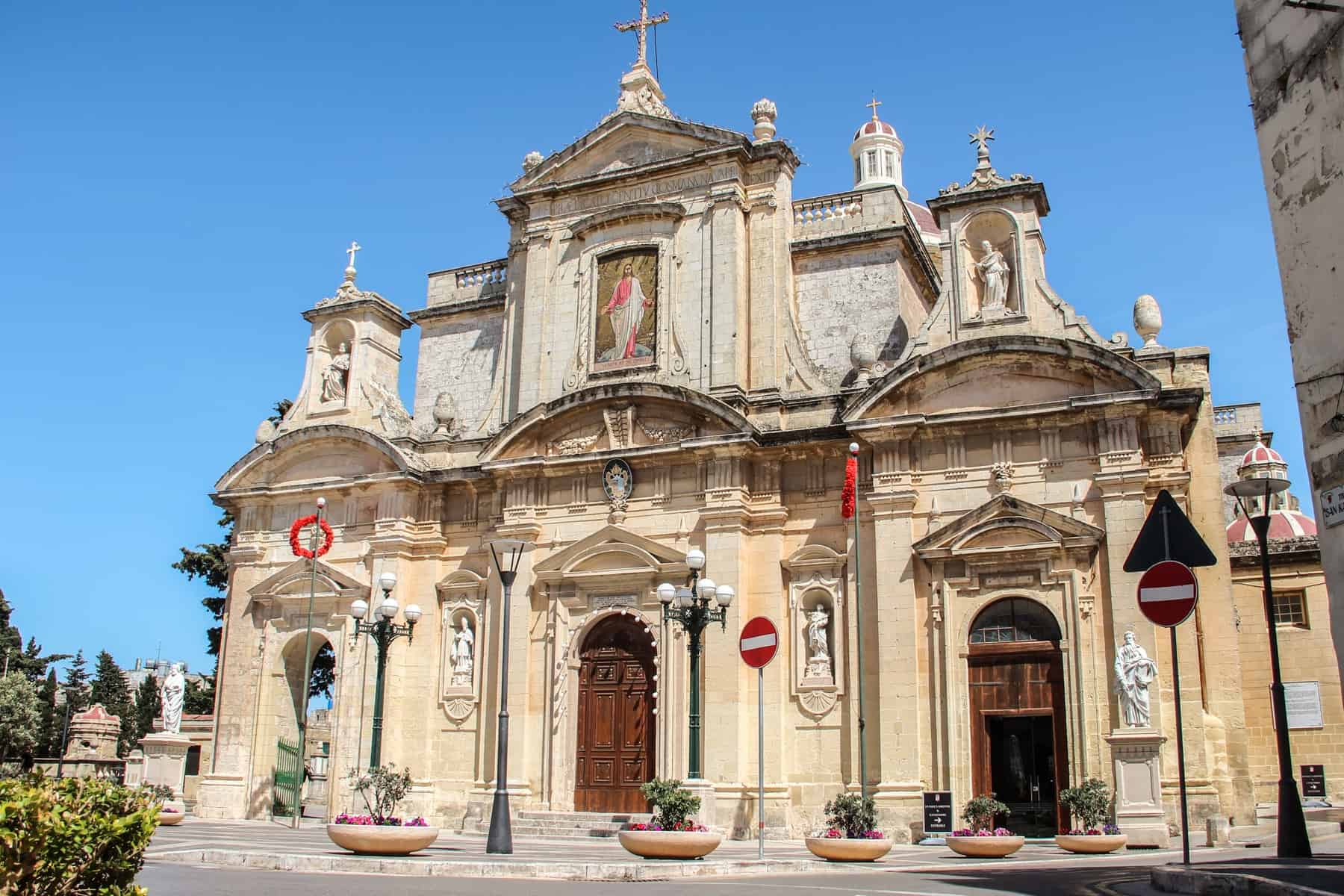
St Paul’s Church in Malta and the entrance to the Catacombs.
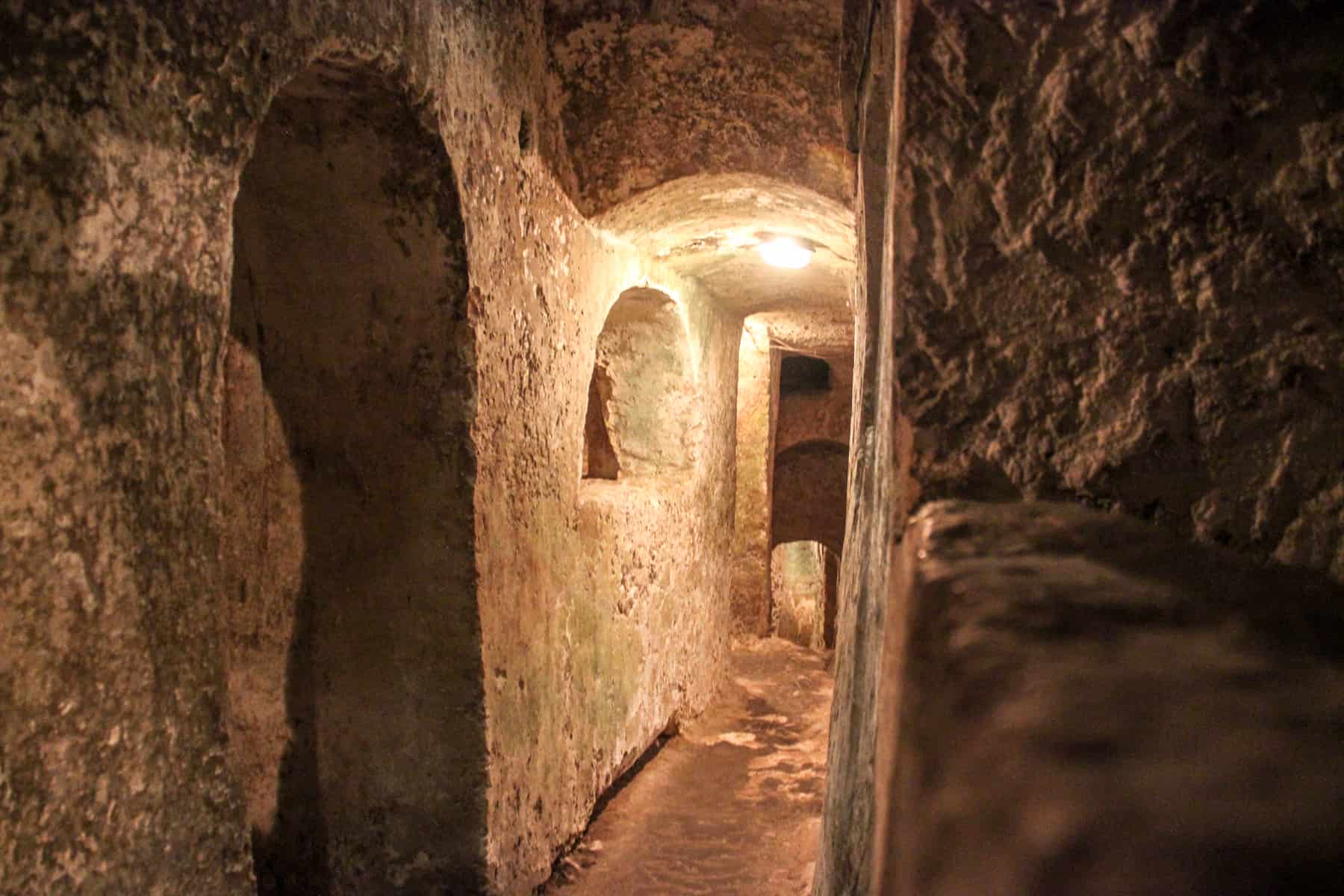
The narrow stone underground tunnels of the Catacombs of St Paul in Malta.
Rabat is also home to the best pastizzi in Malta. Pastizzi are delicious cheese and pea-filled pastries and cost as little as 50 cents apiece. Look out for ‘Crystal Palace’ next to the car park between Mdina and Rabat, just across from the Roman Villa – it used to be a local secret, but not anymore.
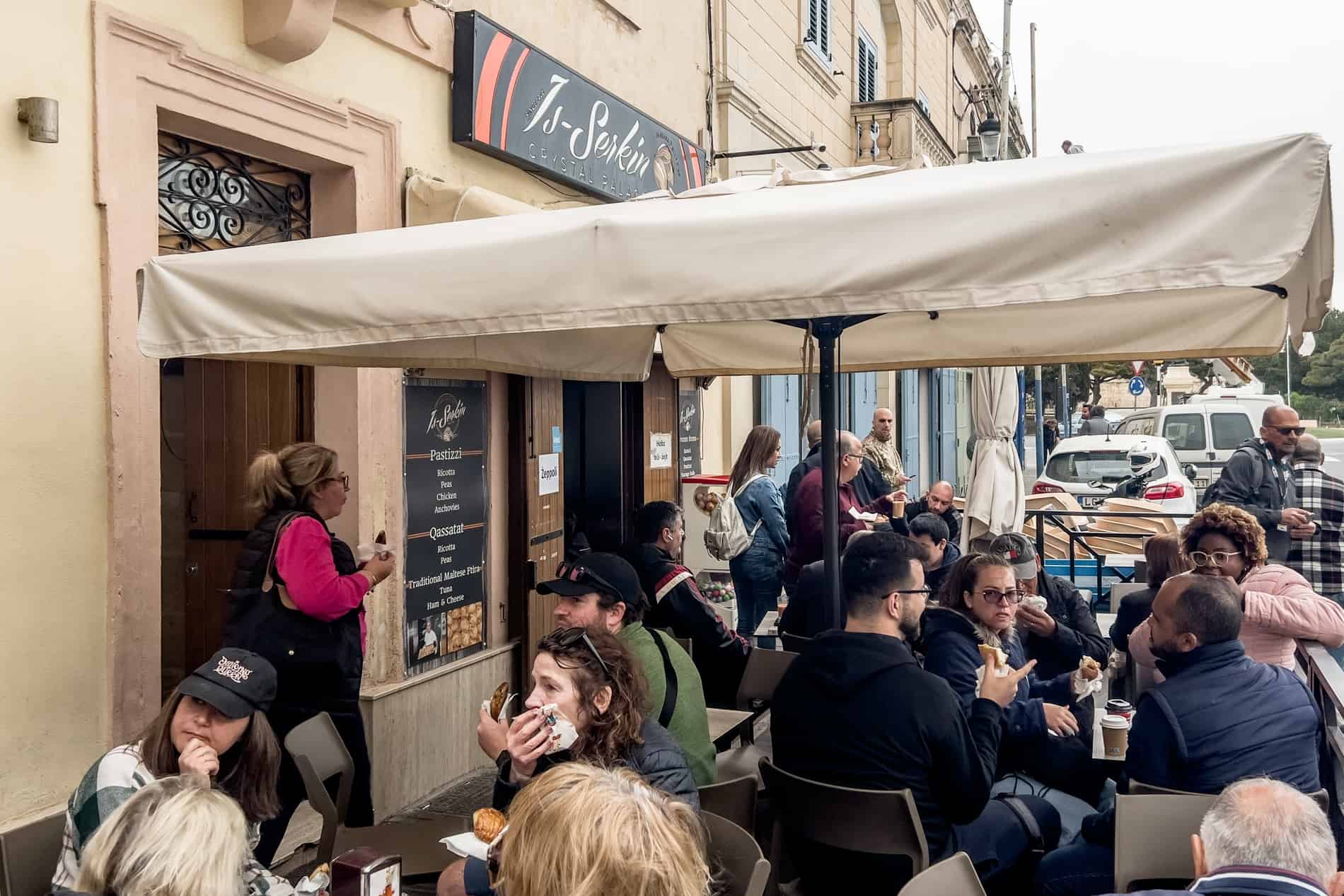
Where can you find the best pastizzi in Malta? Right here.

When in Malta, try the local delicacy, Pastizzi – flaky cheese and pea-filled pastries.
The Brewhouse – The Farson’s Brewery Experience
Malta’s latest experience is The Brewhouse. The former Farson’s landmark brewery site has been recently transformed into a cultural space and state-of-the-art museum detailing the history of Malta’s Cisk (pronounced ‘chisk’) beer brand and the island’s industrial heritage. End your exhibition immersion on the rooftop – it’s home to Malta’s very first Cisk-themed bar, where you can order a fresh pint on tap and enjoy it with a panoramic backdrop of the island. A multi-venue space, there’s also a bistro and gastropub onsite.
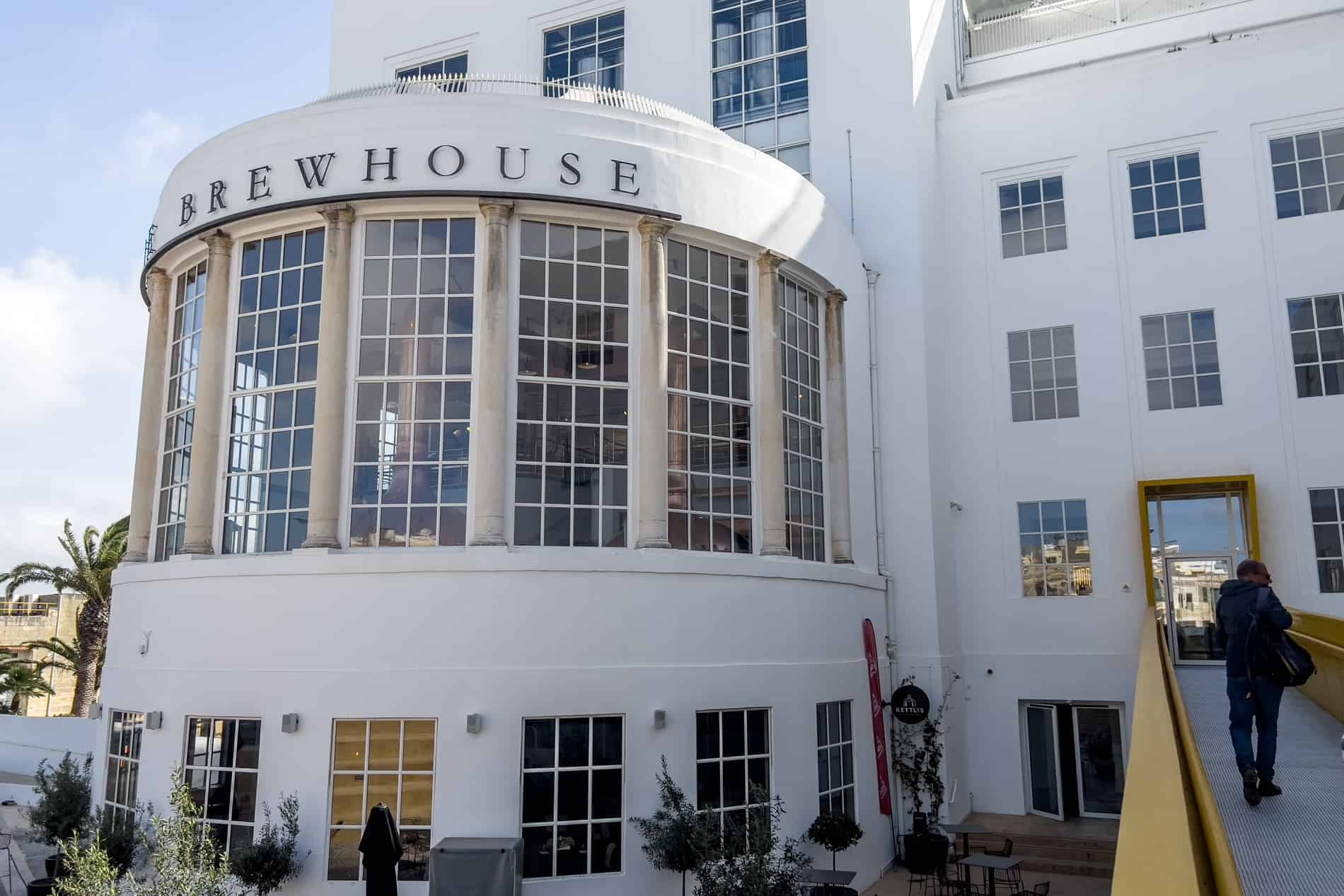
The Brewhouse – historic industrial landmark turned brewery museum experience.
Dingli Cliffs Hiking Hotspot
One of the best viewpoints on Malta is from the Dingli Cliffs. The best way to experience the panorama is on wheels, so hire a Segway and roll along the stunning coastline. This is also a top hiking spot for the ramblers on the island.
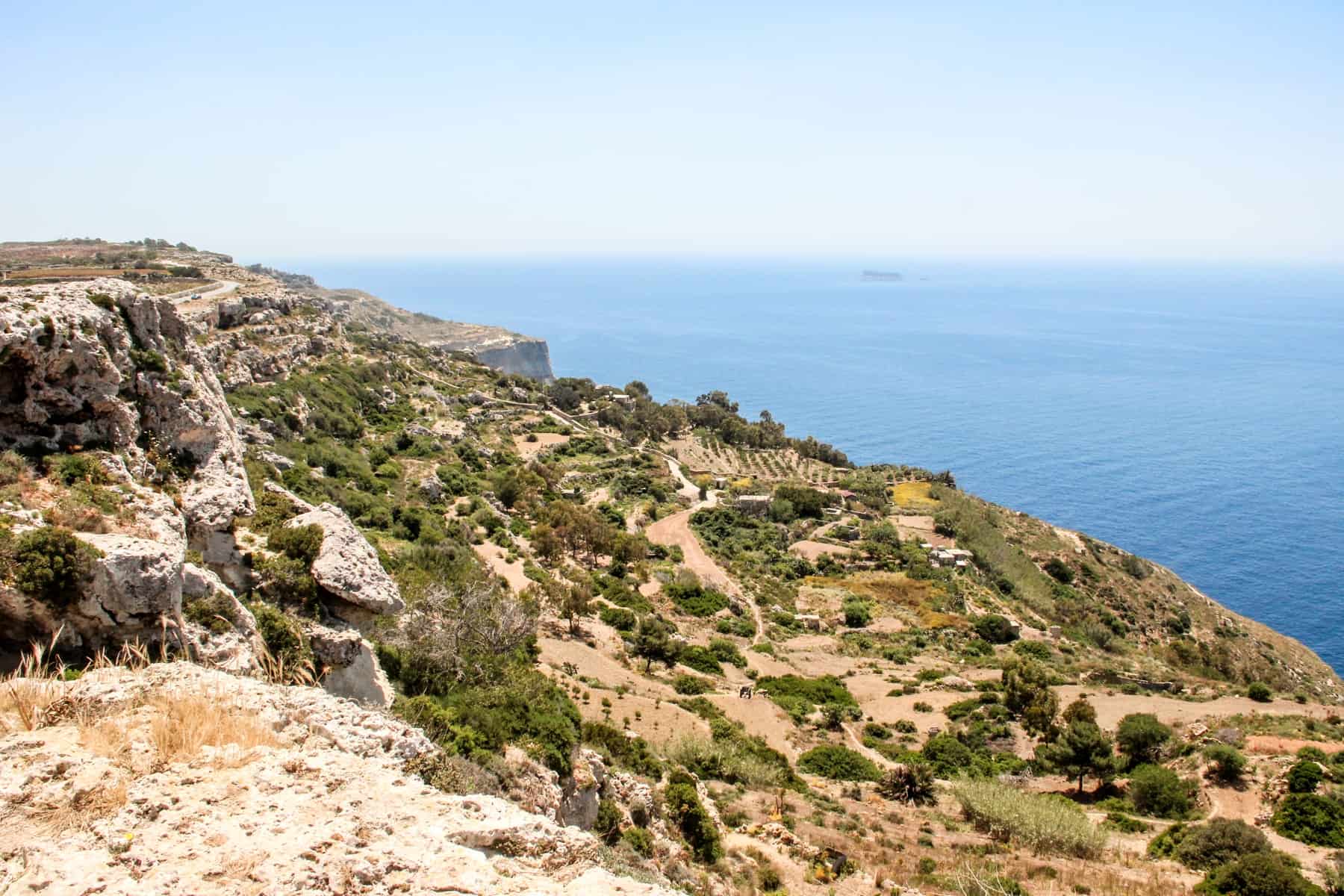
The winding, rocky Dingli Cliffs of Malta are perfect for hiking.
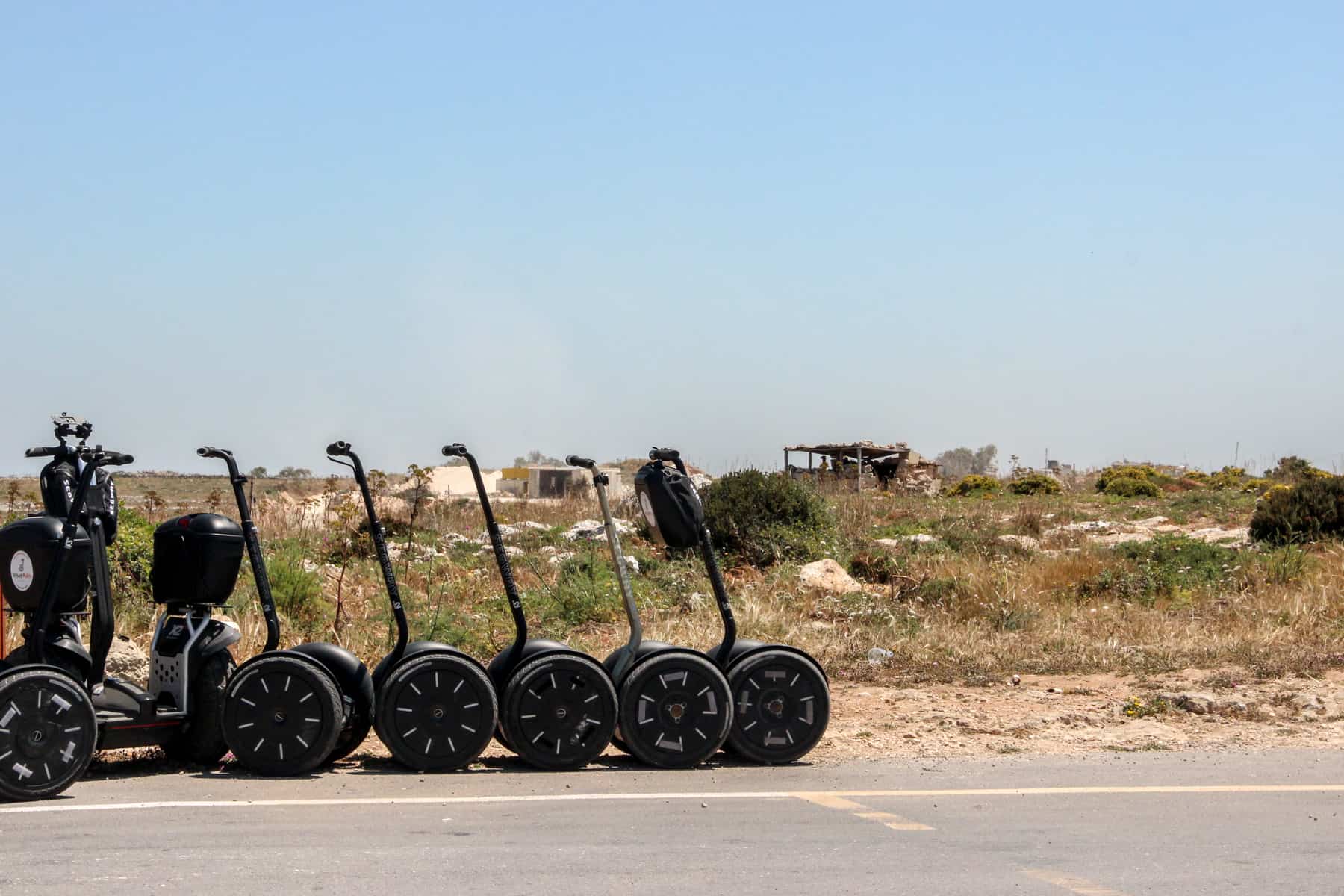
A segway trip in Malta is one way to cover some sightseeing grounds.
Girgenti Olive Groves and Vineyards
Between the coastline and the city of Siggiewi is an unspoiled patch of countryside called Girgenti, where palatial limestone structures and streets are swapped for farmhouses and valley-like roads. Its landmark is the historical Girgenti Palace, built in 1625 as the summer residence of the Catholic Malta Inquisitors and, later, the British Lieutenant Governors.
A blanket of soft rolling wild green resembling Gozo’s landscape, visit the olive groves, where you book an experience with Karlito’s Way to taste the local olive oil batch and learn how to make a Maltese Ftira – a sourdough bread layered with tasty toppings and cooked in a wood-fired oven. Just don’t call it pizza! Combine your time here with a wine tasting at nearby Ta’ Betta Wine Estates – a four-hectare vineyard specialising in fine wines.

Making Maltese Ftira in the Girgenti Olive Groves.
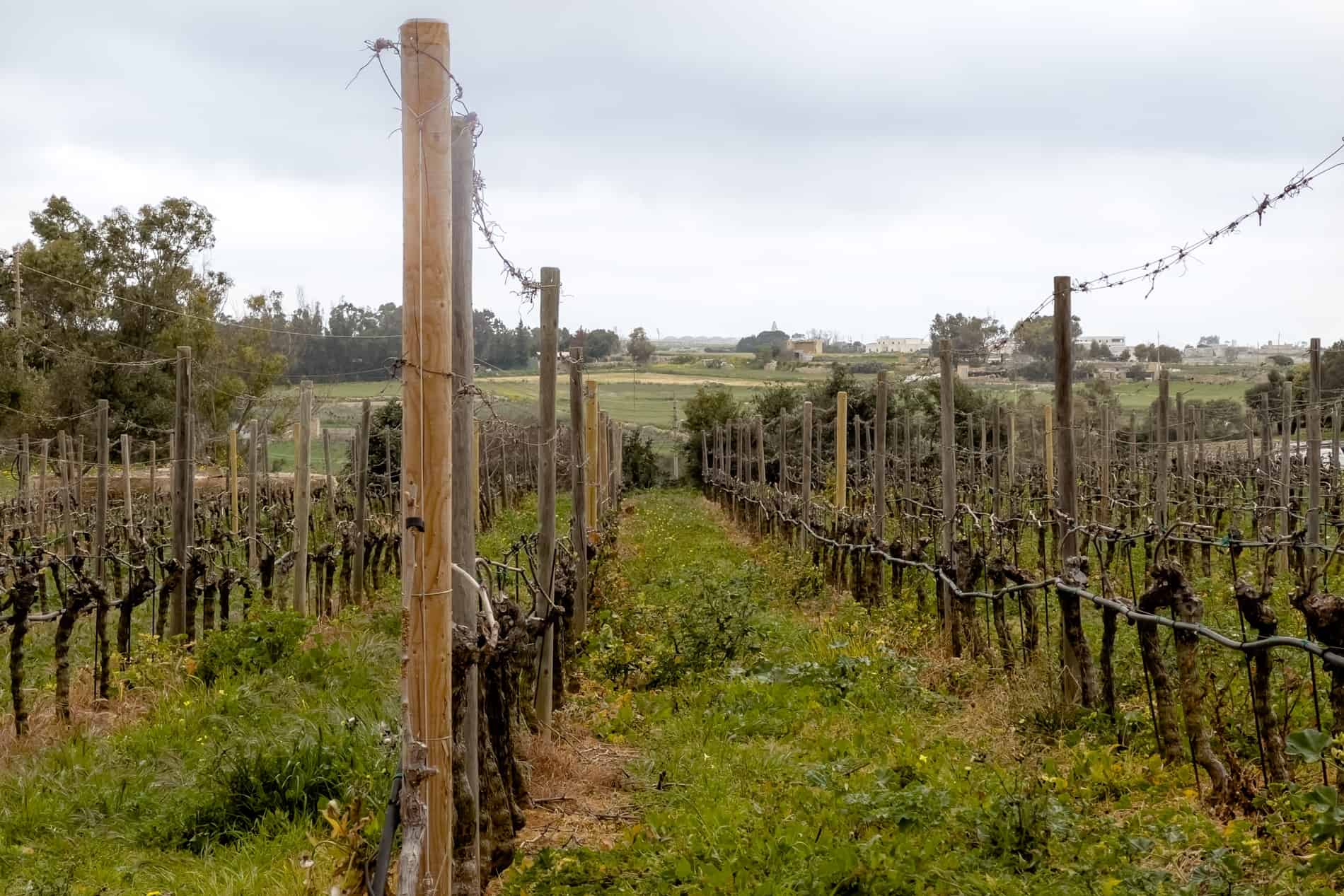
Ta’ Betta Wine Estates in Girganti, Malta.
Ghar Lapsi for Maltese Nature
You’ll soon find the spot on your journey along the Dingli Cliffs where you can capture the view of Filfa Island in the distance, tour the temples of Hagar Qim and Mnajdra, take a boat trip out to the Blue Lagoon, or, if you are lucky, find the local hideaway and hidden beauty of Ghar Lapsi.
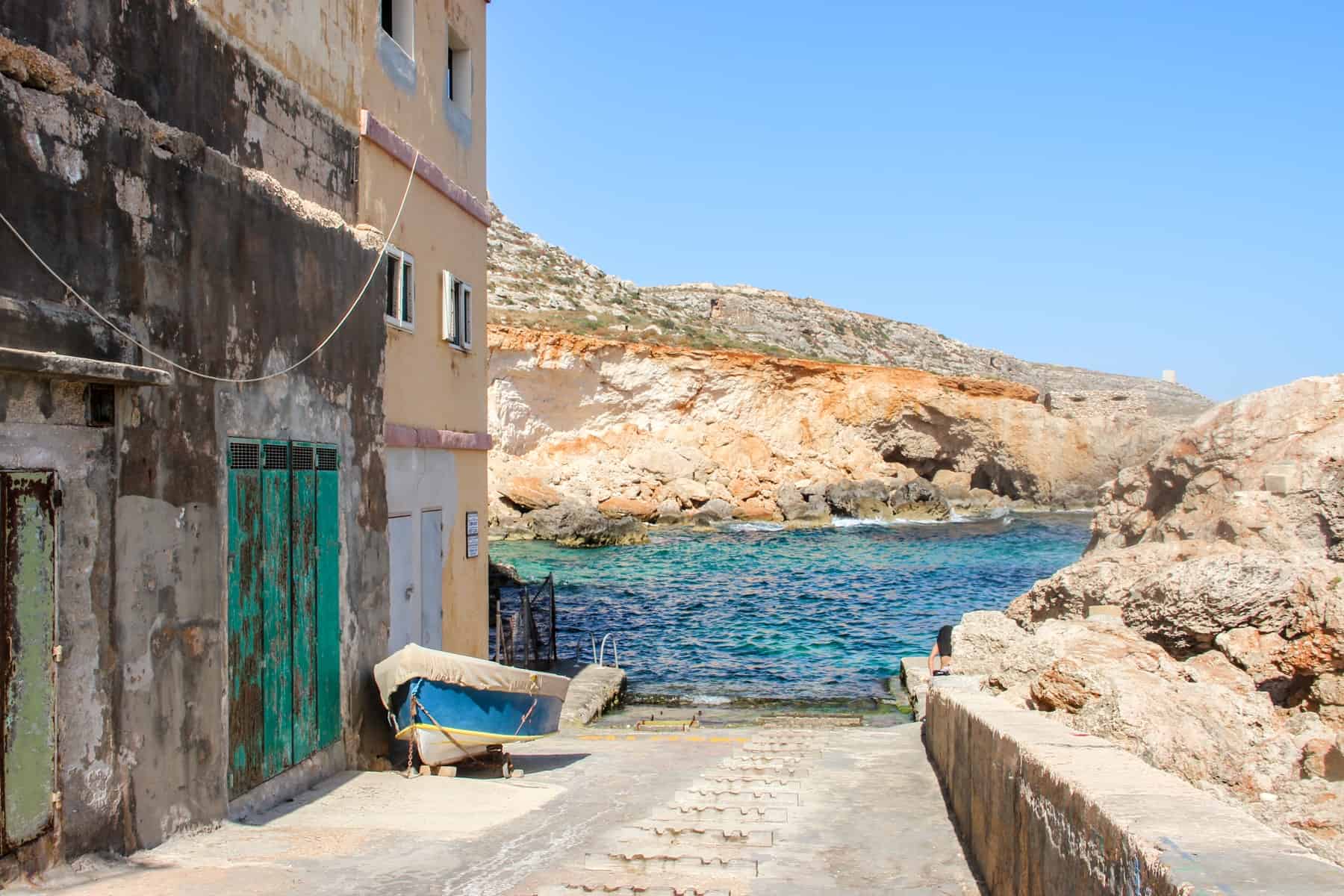
Quiet, hidden coves in Ghar Lapsi.
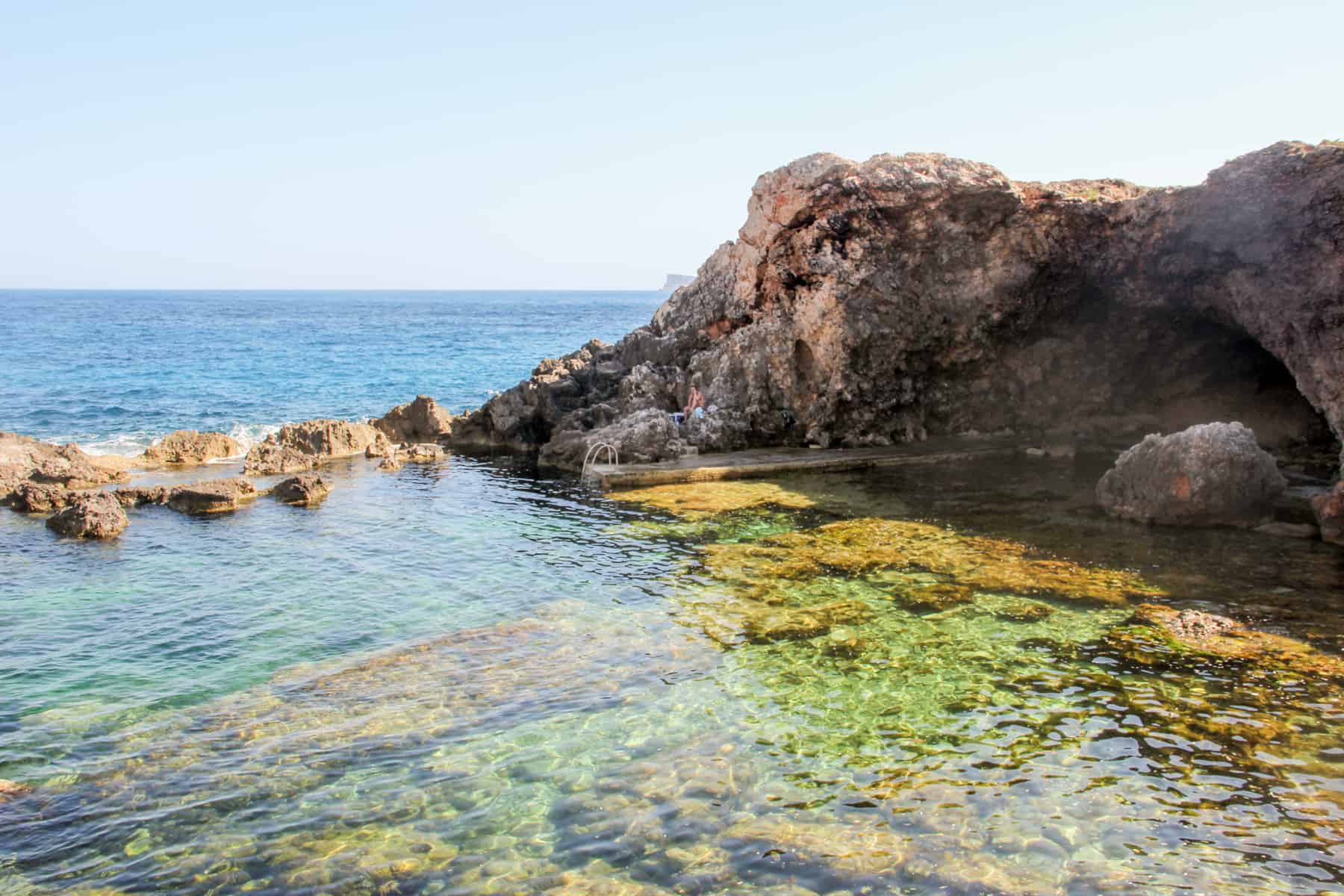
Ghar Lapsi is full of stunning, secluded bays.
Zebbug Local Maltese Village
If you are keen to see Malta’s local life at its best, Zebbug is a good insight into a secluded area of Malta that visitors never frequent. For a real village atmosphere, visit the town in the first week of June when the feast dedicated to St. Philip is underway and traditional music, food and fireworks are in full swing.
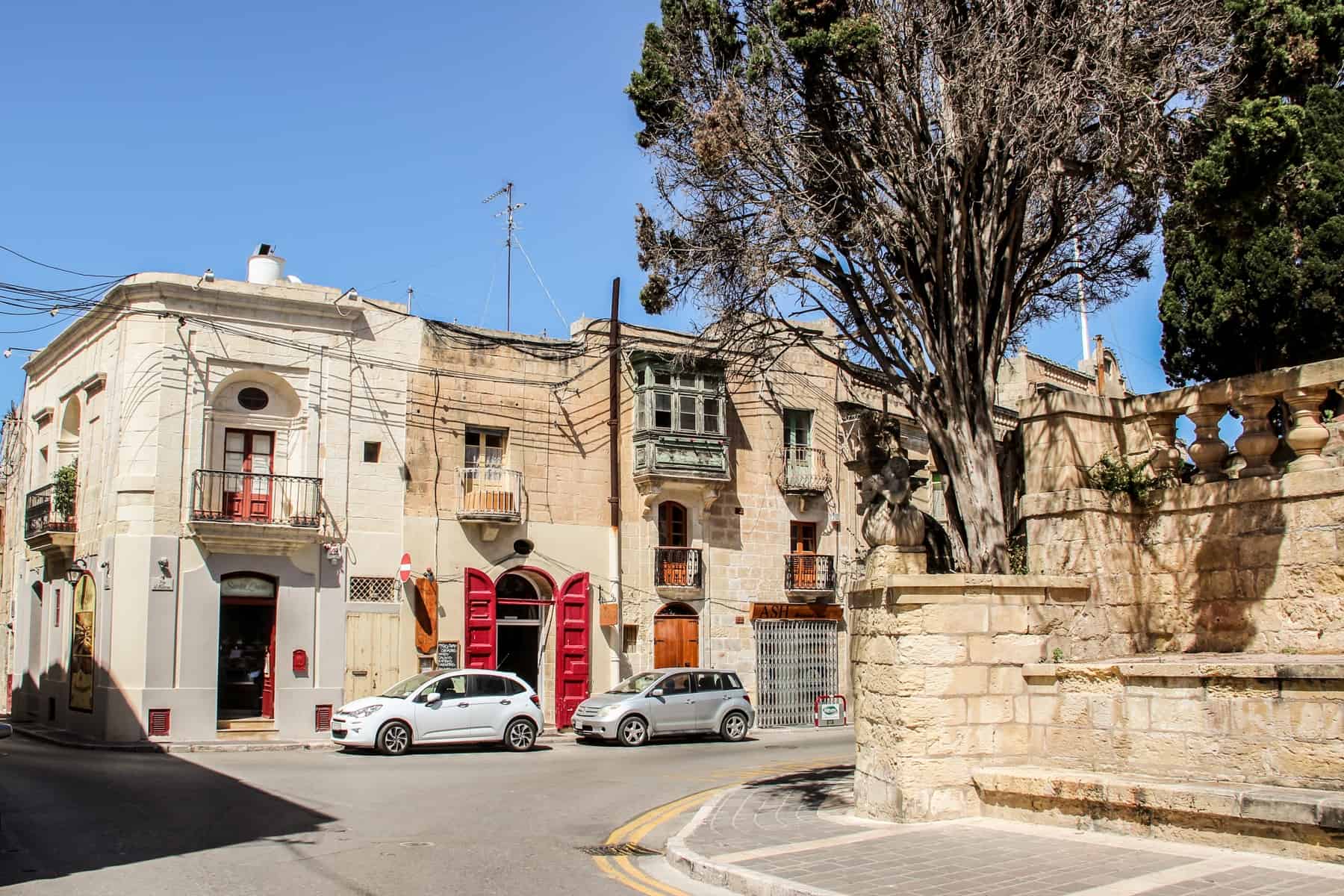
Maltese village vibes.
Marsaxlokk Fishing Village
This pretty fishing village of Marsaxlokk is great just to come and look at the traditional boats that fill the water. And the coffee is VERY cheap. Overall, a peaceful hangout with a colourful view of the island’s south.
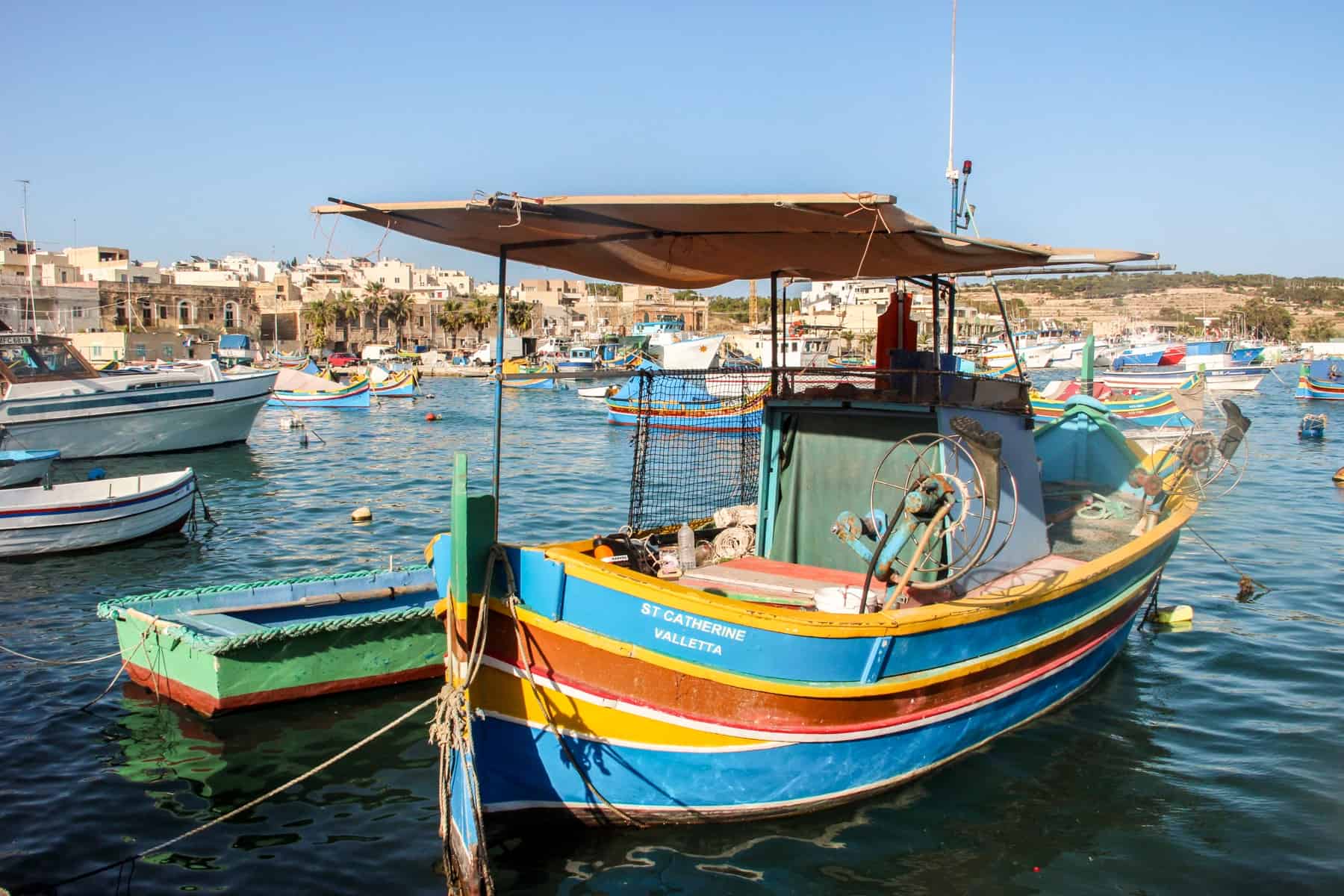
The picture-perfect fishing village of Marsaxlokk, Malta.
Sliema, But Only for the View
I wasn’t a fan of Sliema – Malta’s modern island addition that somewhat ruins its classic skyline. However, staying away completely means missing out on Tignepoint – a breathtaking view of Valletta which glistens at sunset.
Sliema also has a convenient ferry port for full-day sailing trips to Camino Island and the Blue Lagoon.
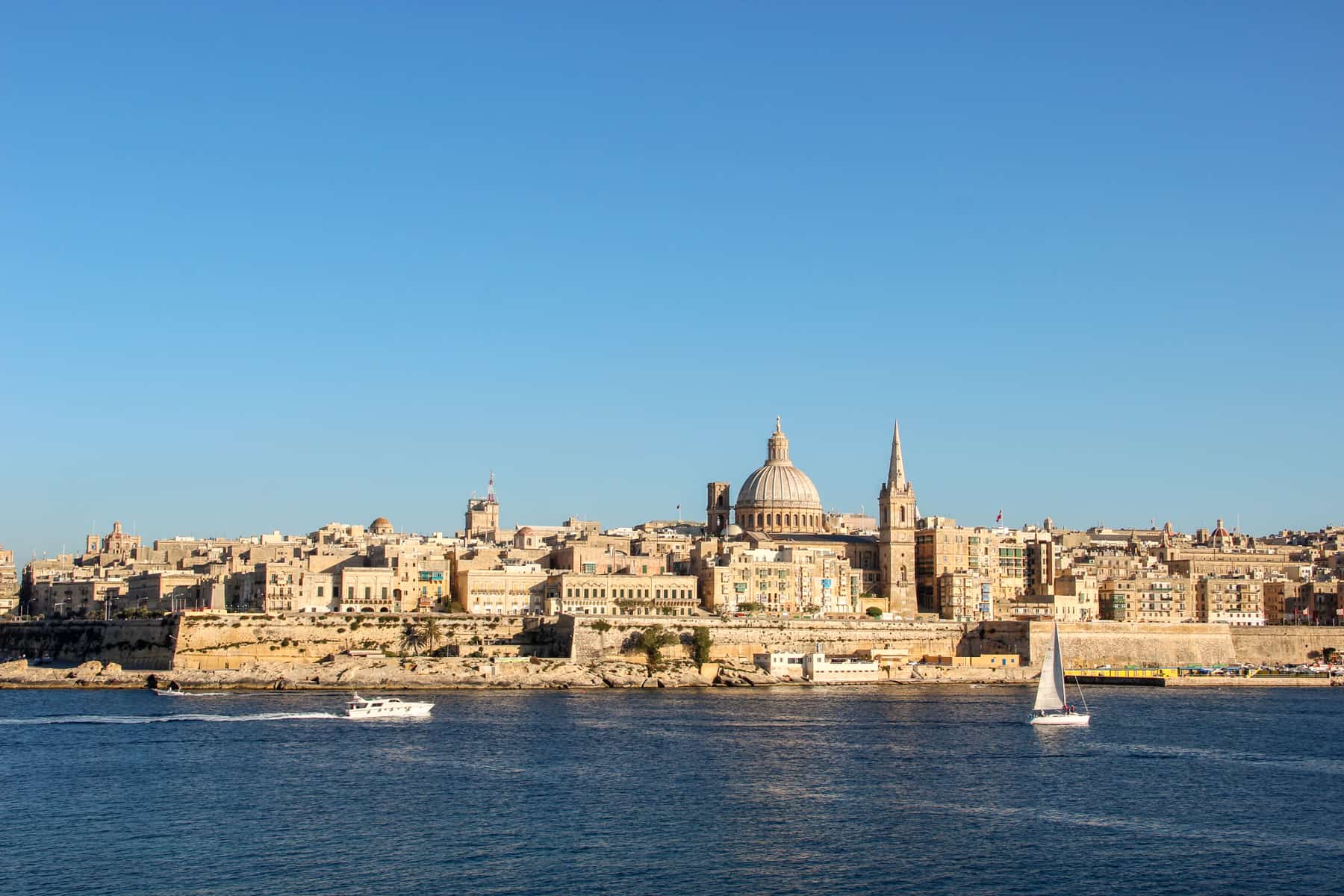
A view of the golden structures, spires and domes of Valletta, Malta, from Silema.
Mosta Dome – The Beloved Landmark
Mosta Dome is the fourth-largest unsupported dome in the World, known for surviving an air raid in 1942 where two bombs bounced off the dome, and another went through, hit the statue of Jesus, landed amongst the congregation and did not explode. A local miracle and a much-loved landmark.
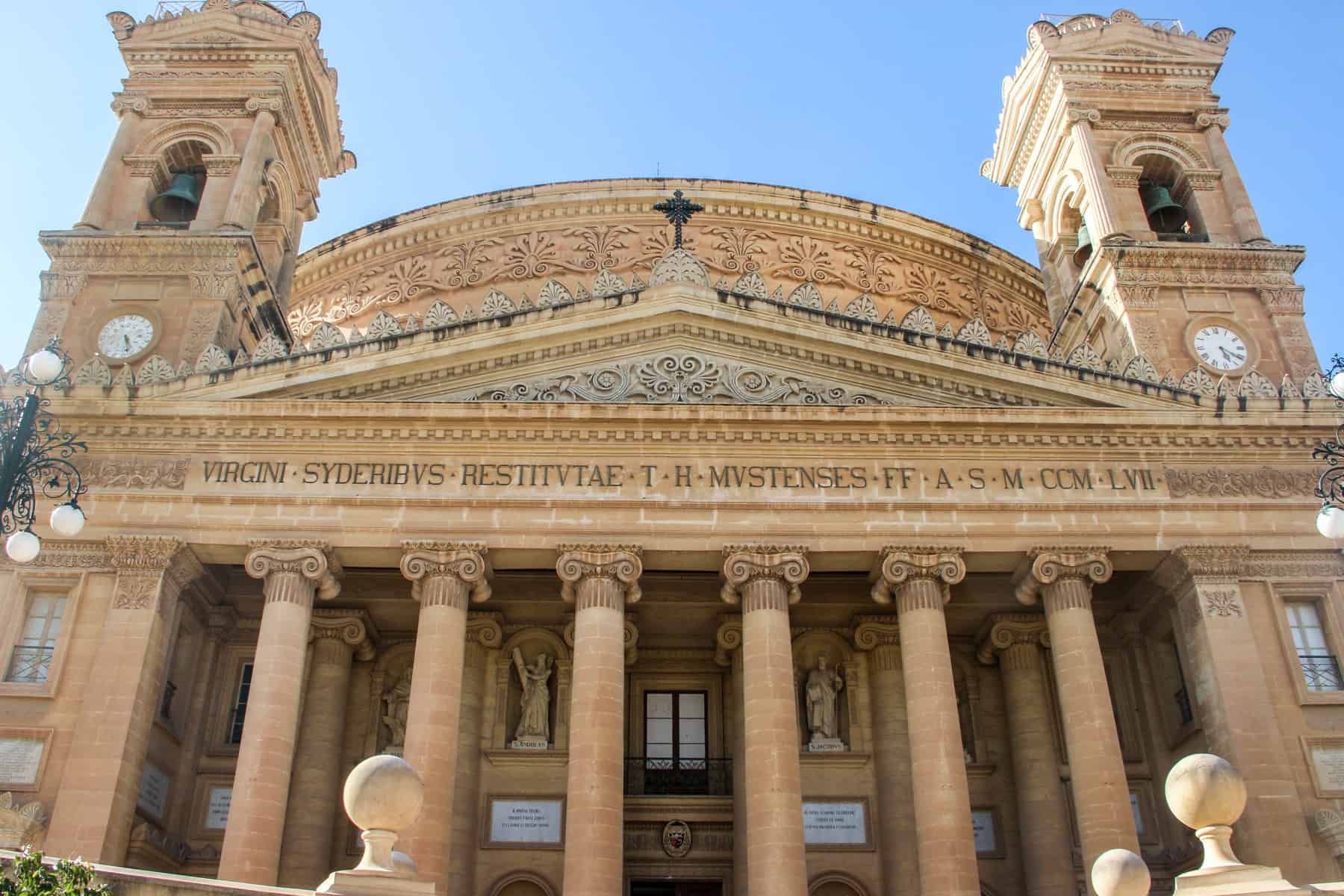
Mosta Dome in Malta has an interesting history.
What to See in Malta – On the North of the Island
Thought southern Mata was packing with sights? It’s time to head to the North to see even more.
Paceville
Pumping Paceville, with its bars, nightclubs and restaurants, marks the St Julian’s Bay area as the place to be when your day of sightseeing ends. It’s young, fun, and verging on the side of tacky (in parts), but consider a pub crawl and join a group to visit a few bars and nightclubs.
Those who spend their holidays in St Julian’s Bay may not necessarily be here for the Malta culture. Still, you too might have to admit liking it just a little, especially if you score a restaurant balcony with a harbour view.
Bugibba and Qawra Village
Once farmer towns and fisherman’s villages, Bugibba and Qawra are now busy tourist hotspots on the island. However, the promenade offers a lovely walk during the summer evenings, where you can capture some beautiful shots of the surrounding vista.
Mistra Bay
You need to detour off the main road to reach Mistra bay; once you pass Xemxija and enter the valley, be sure to follow the small signs signalling the winding roads to Mistra Bay, where you will gain access to what is more of a local hangout.
For the more adventurous out there, following the coastline northbound by foot allows you to peer into a once-fortified turret, capture close-up shots of St. Paul’s Island and follow one of the many hiking trails in the area.
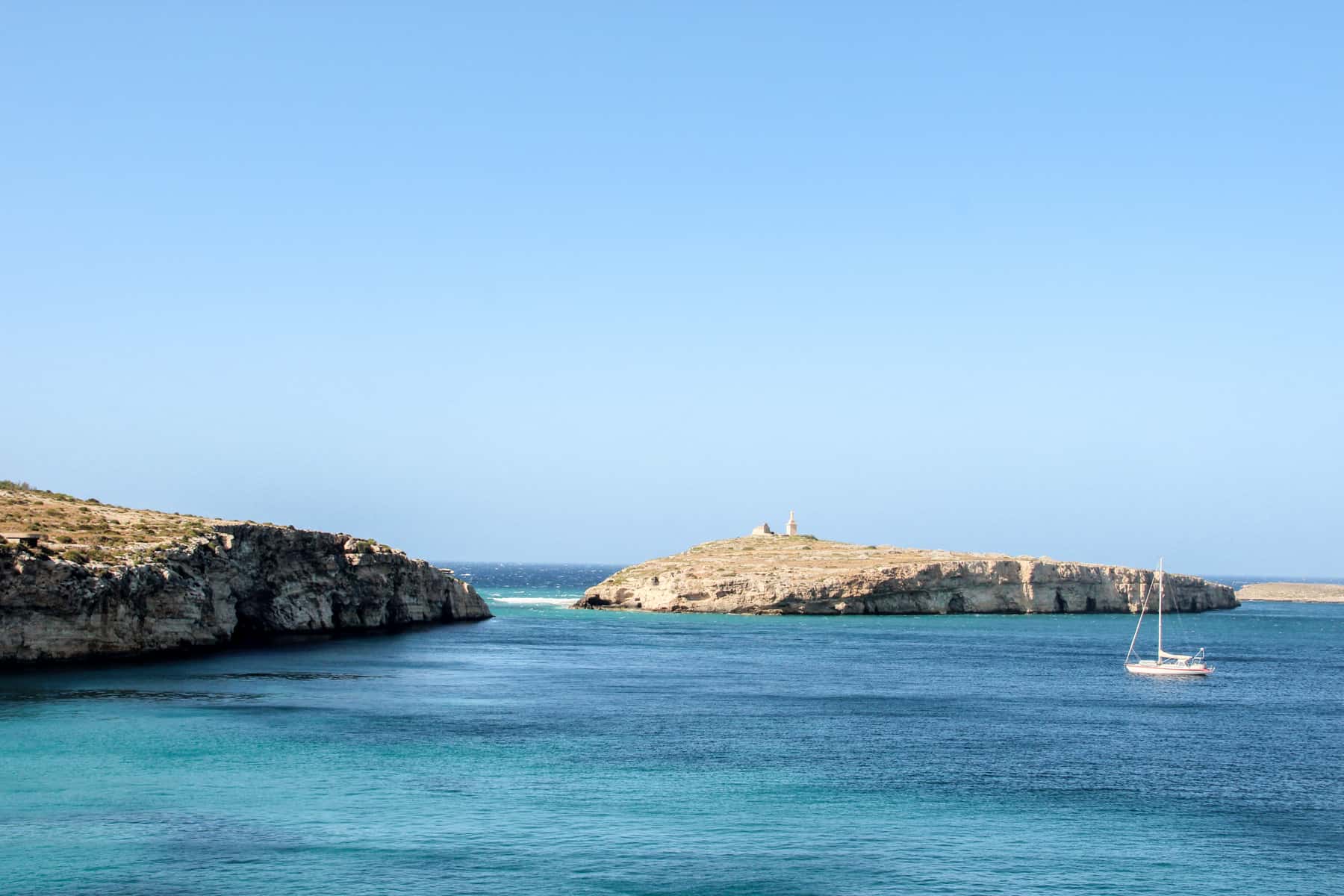
Sailing on the shores of Malta.
Gnejna Bay Local Beach
Gnejna Bay is small, cosy and out of the way, although when I arrived here, it was very windy, and the waves were choppy. However, catch this area on a good day, and you’ll soon see it’s a secluded spot to escape the crowds and hang out with the locals.
Joe, the resident car park attendant, has been working at the beach for roughly 20 years and is a great source of insider information about the area.
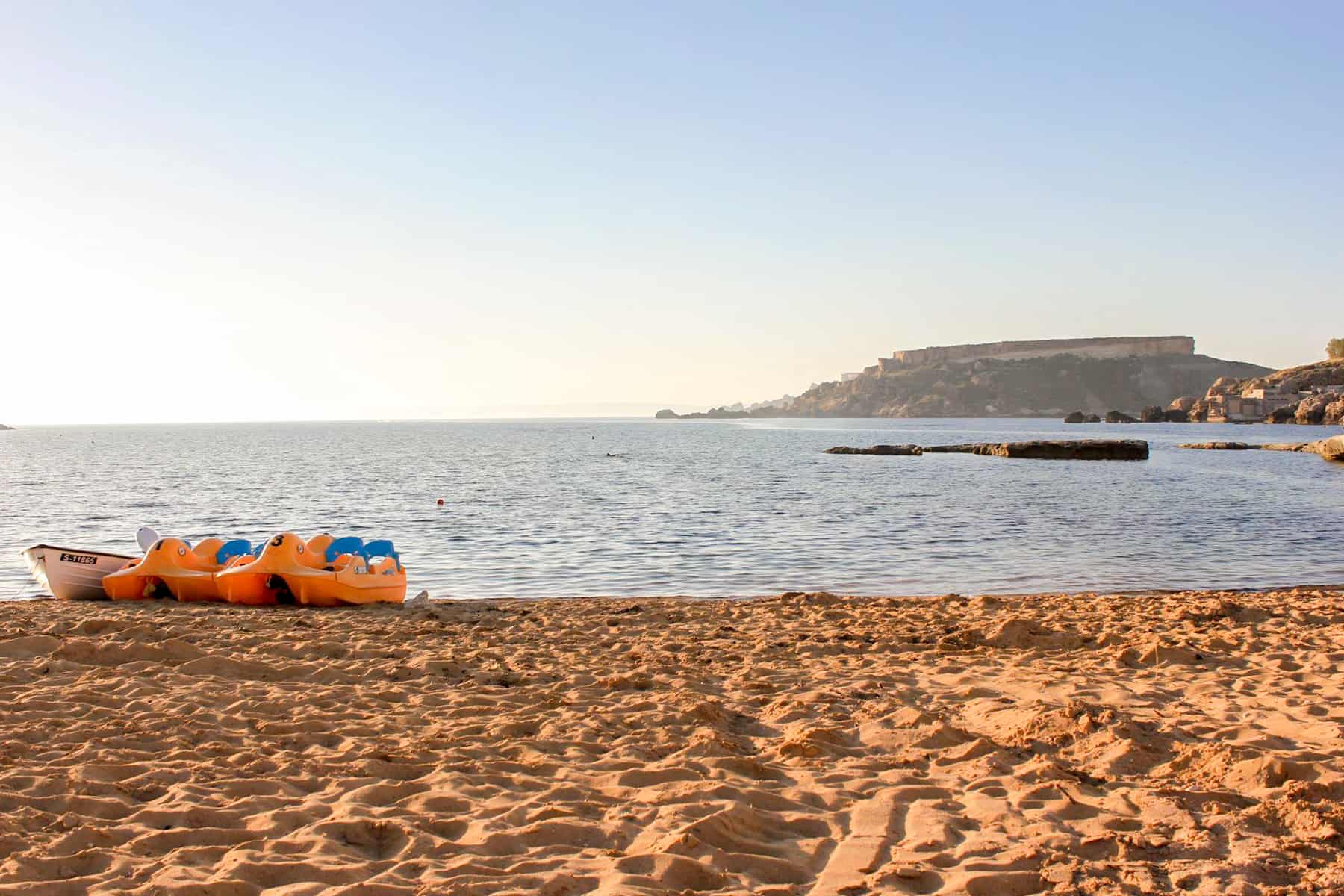
Gnejna Bay – one of Malta’s best local beaches.
Ghajn Tuffieha Natural Beauty – Riviera Bay
Also known as Riviera Bay, the sandy cove at Ghajn Tuffieha will lure you in as soon as you see it from up high. Don’t be put off by the many steps leading down to its sandy shores because this area is just too gorgeous to miss and has one of the best beaches in Malta. Singita Miracle Beach bar offers music and cultural arts entertainment here.
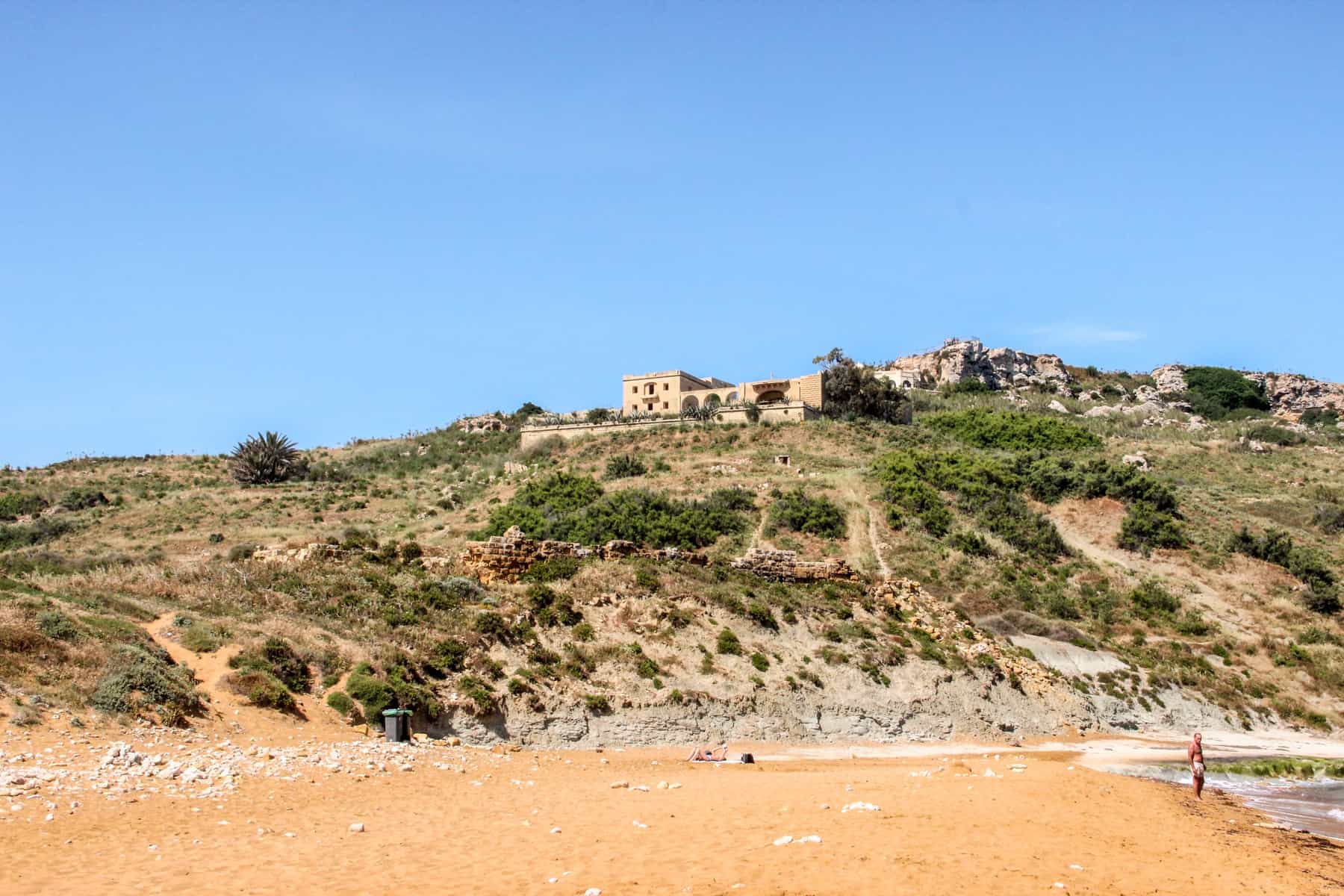
Climb down into the sandy shores of Ghajn Tuffieha beach.
Golden Bay Viewpoint
Head to one of the viewpoint restaurants and enjoy the view. It’s that simple in Malta. Golden Bay attracts the younger crowd during the summer months, and it tends to be the busiest of the four mentioned beaches.
Mellieha Bay Beach Time
Add Mellieha Bay to your list if you are not bored with beaches and bays. Perfect to try out water sports and work on the tan, there are half a dozen amazing ice cream vendors here too.
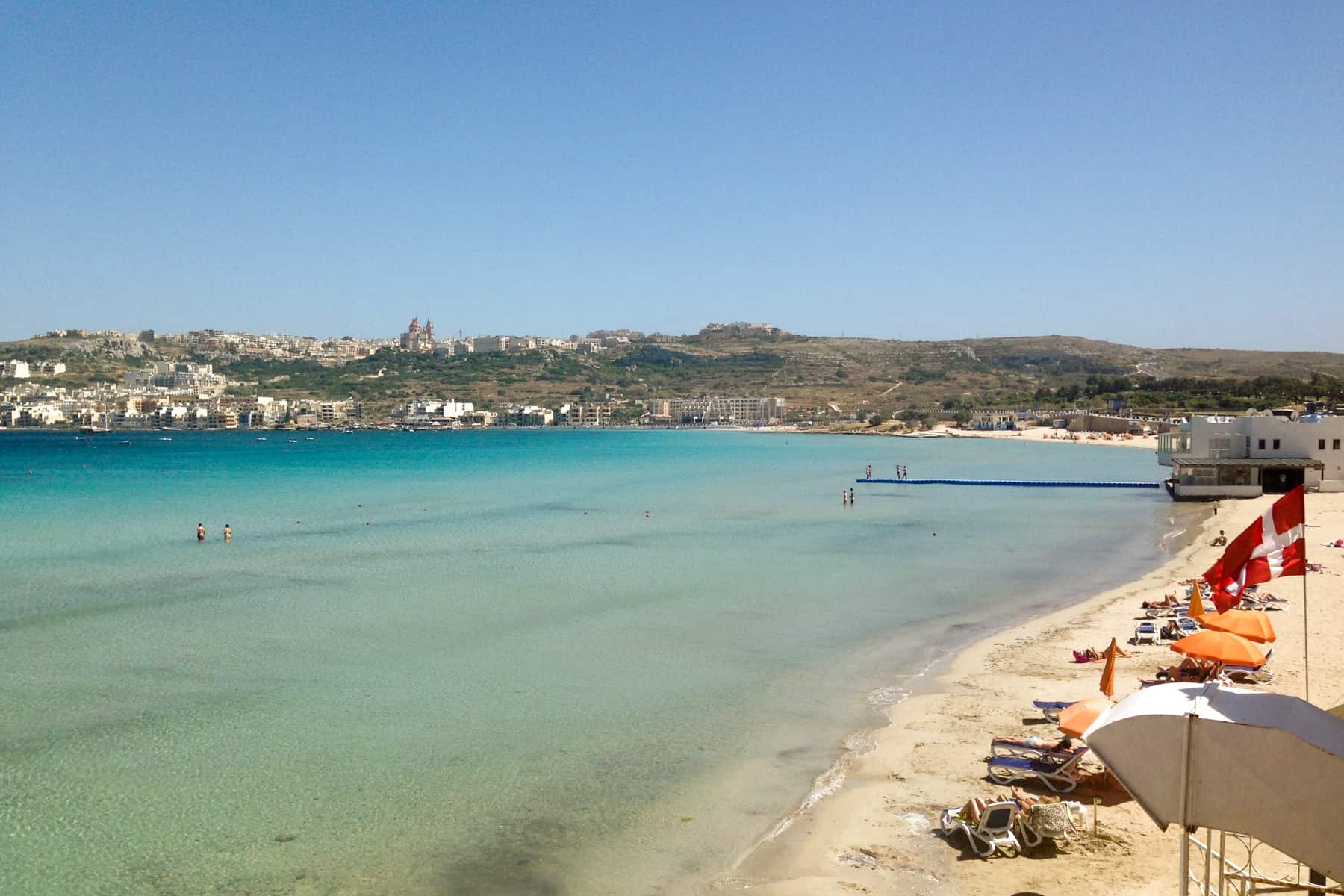
The long coastline and yellow sand beach of Mellieha Bay, Malta.
The Red Tower Area Secluded Viewpoint
Looking over the entire north end of Malta, the Red Tower provides 360 views across both land and sea. Set up as part of the defence strategy of the islands, it is open on certain days of the year (check the Heritage Malta website regularly), and access to the Red Tower is as simple as the rest of Malta – once you see it, you can drive straight to it.
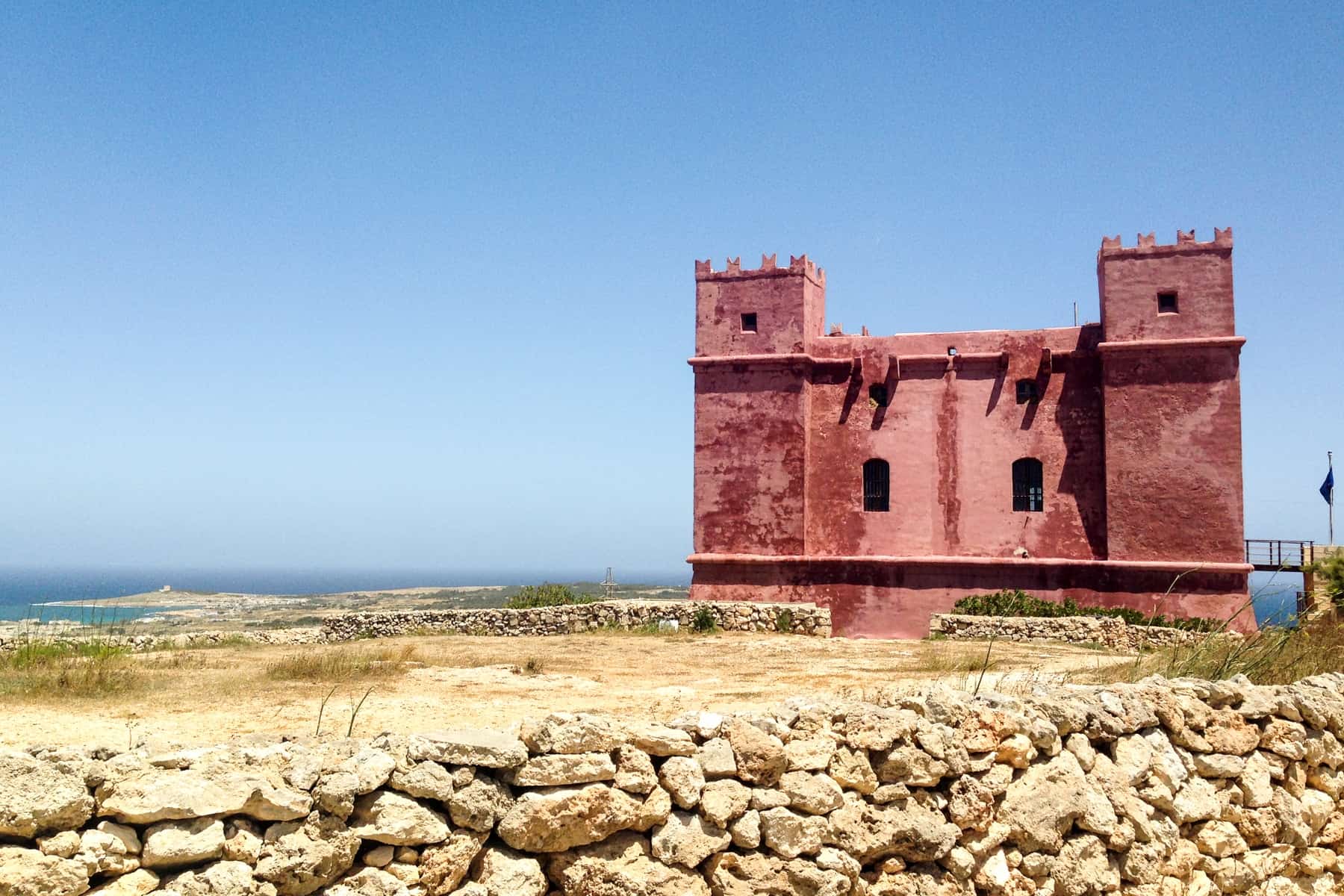
Check out the clifftop panorama views from Malta’s Red Tower.
A Little Chapel With a Difference
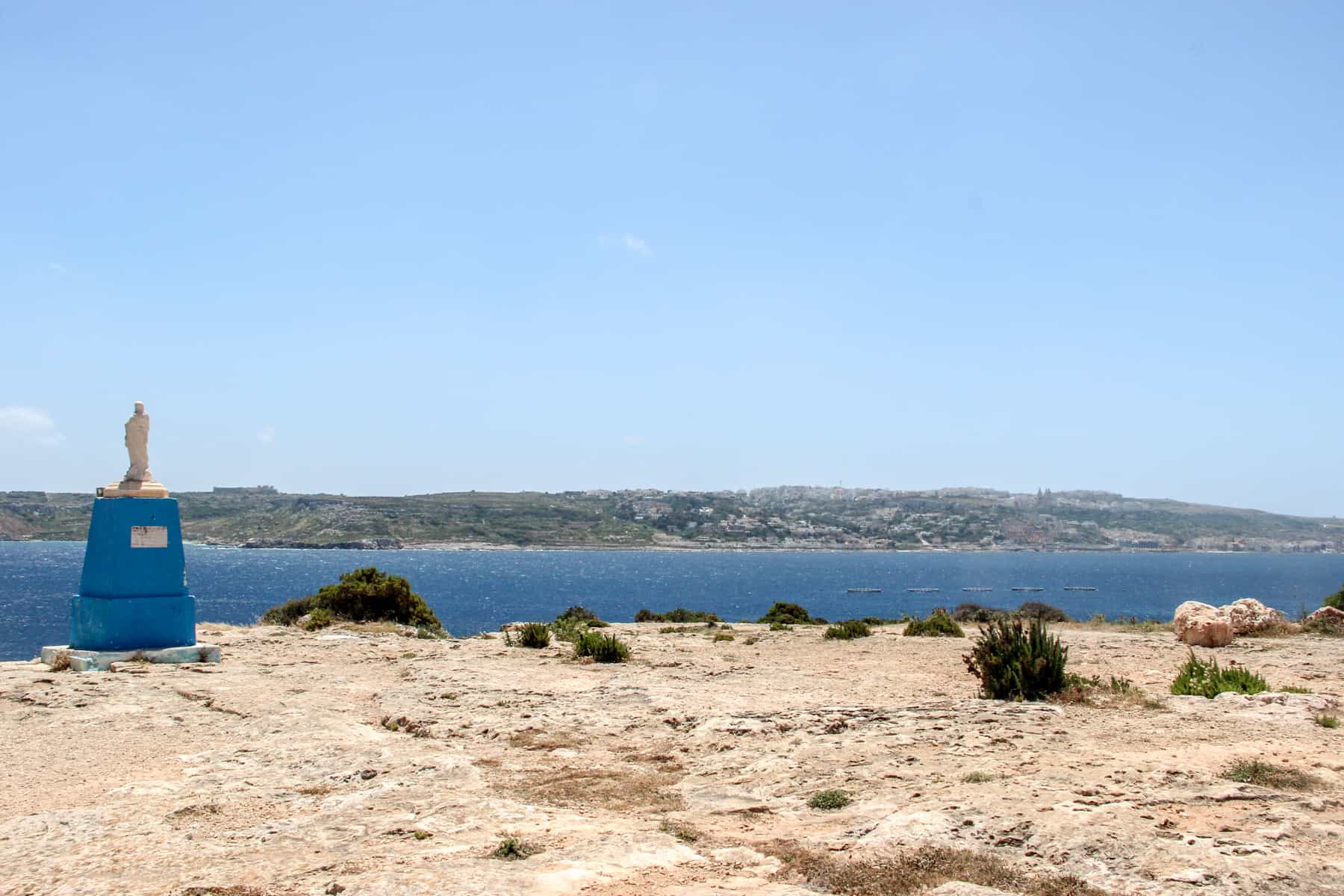
Find the Little Chapel of Malta in L-Ahrax.
Situated on the opposite side of the Red Tower, this area known as L-Ahrax is commonly used for cliff camping since the area provides a stunning view over Mellieha Bay to one side and Comino on the other. Following the road to the tip, you’ll come across a little chapel – this mix of culture and scenic beauty gives Malta its unique persona.
Is Malta Worth Visiting?
Before my Malta trip was planned, I didn’t know much about it beyond the British connections. I soon saw that Malta travel is more than its main draw, Valletta (which is incredible), but about a small island of sizable variety – in landscape, architecture, history, culture, and cuisine.
One end of the island differs from the next, and you can switch from a walled city to a tiny village and from a bustling beach to a secluded cove within minutes. It doesn’t get more diverse than that, and that’s not even considering Malta’s sister islands of Gozo and Comino.
I may have been invited by Malta Tourism and the main Maltese airline, Air Malta, but all opinions remain my own. I spent extra time living with a local friend and exploring the island in order to gather further information for this article.


Sagar Kole says
Hey, I truly enjoyed, reading this post. I was just searching for road trips & came across your post. As you said 4 days in Malta will be perfect, but I would be there only for 2-3 days (Most probably in January) & is January a good time to visit?
By the way thanks a lot for sharing. I have bookmarked it for future planning 🙂
Bloom says
If you go to Malta or Gozo, don’t miss the opportunity to do scuba diving. Malta is one the best spot to dive on earth 🙂 !
Carmen says
You’ve shared such a beautiful pictures of Malta. The island is definitely a hidden gem. As a foreigner living here, I absolutely love it. 🙂 Much love xx
Francesca says
Thanks for your review about our beautiful island (next time you have to go to Gozo too) – just as beautiful as it is more quiet and greener with lots of magnificent views!!
Although Malta is a small island it lacks nothing in architecture, history and traditions.
While you were in Ghar Lapsi, I hope you came to Blue Grotto and did the boat trip to the beautiful caves.
Another must is the scuba diving…. Malta is renowned for this wonderful sport with lots of places to dive and explore.
And our food is to die for…. not just pastizzi 🙂 🙂
Dani Kitz Aurala says
I am so happy to have found your site. You wrote exactly what I felt in Malta. I love the marvelous rock!
Nina Travels says
So happy to find this site. My hubby and I bought plane tickets for Malta in January and we’re also doing a roadtrip. How many days did you need to do this? We have 4, but I think this can easily work out, especially as we are not there for the summer and will not be time for sunbathing. 😉
Becki says
You could easily do all of this in 2-3 days so 4 is perfect! It’s a small island! Have fun 🙂
Guy says
I have been to Gozo in September for the last five years; it’s a charming place with amazing and accessible historical sights, great swimming diving snorkelling, friendly helpful and passionate people, great local food including fresh fish and seafood, lovely nature & exploratory walks, fantastic and varied vistas from viewpoints, and overall amazingly unspoilt – so don’t bother visiting please ! But seriously, if you visit the Maltese Islands and love tranquility balanced with a bit of local bustle, don’t miss out on Gozo, and try and get an invite to a local family barbecue one evening on the rocks (they happen all around on hot summer nights) and bring a bottle or two !
car says
beautiful blog
ps. a great bus network ? hahaha no.
Becki says
Awww, it’s not that bad, come on 😉
Michael says
Hi Becki, I just stumbled across this blog. I must say I was really impressed with how much you got to see out of Malta, and you did lots of stuff which most tourists don’t even know about unless they know a local! I’m from Malta and you really made me appreciate how beautiful my country is. Thanks for the review and thanks for helping to spread the message 😀
Becki says
Thank you! It always helps to know a local! 🙂
Francesca says
Hi becki
Great article about our beautiful islands! Thanks.
I know you mentioned Hagar Qim and Mnajdra but I think they deserve a little bit more of a mention 🙂
According to some historians, our temples are in fact older than the Pyramids! A must see for all those who are planning a holiday. C u soon…
elizabeth says
I am Maltese. What makes malta unique is it s small size history, culture wrapped in sea, sun . It s very safe. Gozo is a must.. so laid back with hidden spots. Visit in may june july. Not in sept too sticky.
kriston r says
You mentioned Marsaxlokk without mentioning the Sunday Fish Market?????
The market is good.
Karl Chetcuti says
My I also add a visit to the beautiful Meridiana Wine Estate in Ta Qali 🙂
Becki says
You can indeed. Thanks for your addition here 🙂
Patrick says
Great pointers Becki, makes me a proud Malteser 🙂
Shell says
Hey, thanks for sharing this info – we’re heading off to Malta later this year with a couple of friends who have never visited the island before.
We won’t have a car most likely but there are places on there that we haven’t yet been to, so I’ve shared your post to our friends to see what they fancy doing. Wanna bet that chocolate cake is in the first half of their list?
🙂
Becki says
Cab drivers are nice in Malta! And you MUST have the chocolate cake, and come back and thank me later! 😛
Carmen says
Dear Shell you can visit all these nice and interesting places with the public transport. No need to have a car. Hope you have a great holiday in our beautiful Malta later on this year B|
Becki says
I did indeed go to Gozo. It’s lovely and I especially loved the Azure Window and Victoria, although I do feel overall that it’s TOO overrated. Had plans to also go to Comino but the winds were too strong to get the ferry across.
Jo Woodall says
I agree with all of what you’ve written. But you forgot to mention the wonderful fish restaurants in Marsaxlokk; there’s a reason why there are so many fishing boats there!! Great place, Malta – that’s why I live here…….
Becki says
Then I shall thank you for the additional insight 🙂 It’s a wonderful place to live!
Jonathan Pace says
Super! We are all so proud of our Maltese islands and everything that they have to offer to everyone!
Shannon Kircher says
Love the review of Malta! My entire family is FROM Malta so it’s fun seeing the reviews of all the towns, and great to see it get a little attention. Super historic and beautiful with its own distinct charm.
Stef says
I definitely have to go to Malta 🙂 It’s quite close to Germany but somehow I’ve never made it there so far 😉 Great post Becki!
Simon says
Great post! Looks like you had a blast in Malta and you made me wish to go and explore the island as well (yep, hard to believe, but I never visited Malta.). The architecture looks awesome as well as some spots on the coast and I wonder why I never thought about visiting in all those past years.
Well… It’s never too late 🙂
Becki says
It’s never too late. The beauty of Malta is that it isn’t ruined, and I really feel it will maintain it’s natural beauty and historical architecture for a long, long time!
Sand In My Suitcase says
We’ve only visited Malta a couple of times by cruise ship (and that was really only Valletta). We’d like to see more of the island – and also visit Gozo (hear that’s quite lovely too, offering more nature).
Shannon Kircher says
Gozo is a total must in my opinion! Gorgeous little island with some seriously beautiful hidden spots!
BM57 says
Gozo is different less urban and beautiful to see. Both Malta and Gozo have their own specials. If You visit Malta You must see Gozo as well. I was living there before now I live on Malta and I still visit Gozo from time to time as its special place for me.
Becki says
I went to Gozo on a day trip and it was beautiful! People should definitely combine both islands in one trip.
Ada says
Next month I will visit Malta for 4 weeks and I definetly want to go swimming! I will stay in St.Paul’s Bay so do you have any recommendations for me?:-)
Rachel says
I really like how you’ve included a mix of history, architecture, nature and local culture. I think this is going to have to be something to save towards, thanks for the maps! 🙂